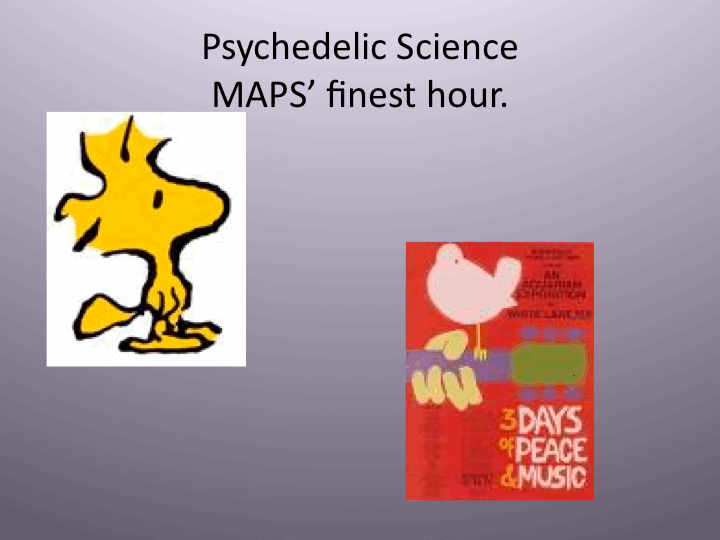Psychedelics in the Psychiatric Emergency Room
Presented at Psychedelic Science in the 21st Century, April 15-18, 2010
by Julie Holland
Apr 2010
Citation: Holland J. "Psychedelics in the Psychiatric Emergency Room: A Slideshow Presentation at Psychedelic Science in the 21st Century, April 15-18, 2010". Erowid.org. May 26, 2010. Erowid.org/culture/characters/holland_julie/holland_julie_ps21c_presentation1.shtml.
The following was transcribed from a presentation made by Julie Holland on Saturday, April 17th, 2010, at the Psychedelic Science in the 21st Century conference held in San Jose, California. The text, conversational in tone, is based on Holland's PowerPoint notes; the talk was designed to provide continuing medical education credits (CME); minor edits have been made to allow the presentation to be more accessible for the layperson.
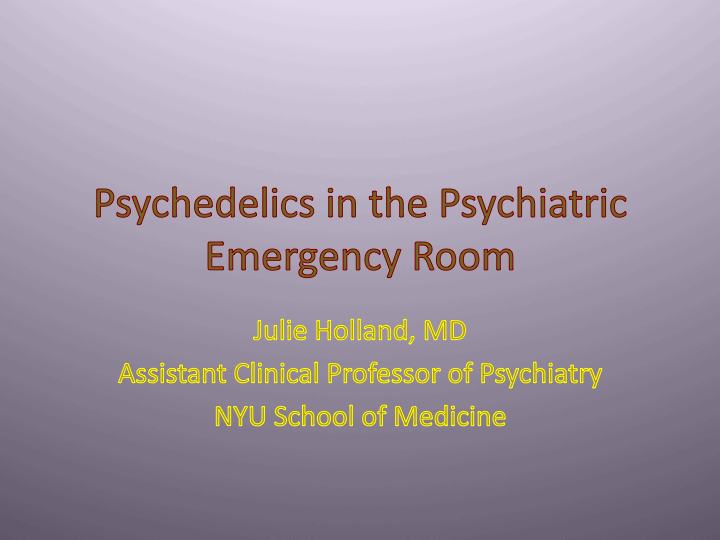
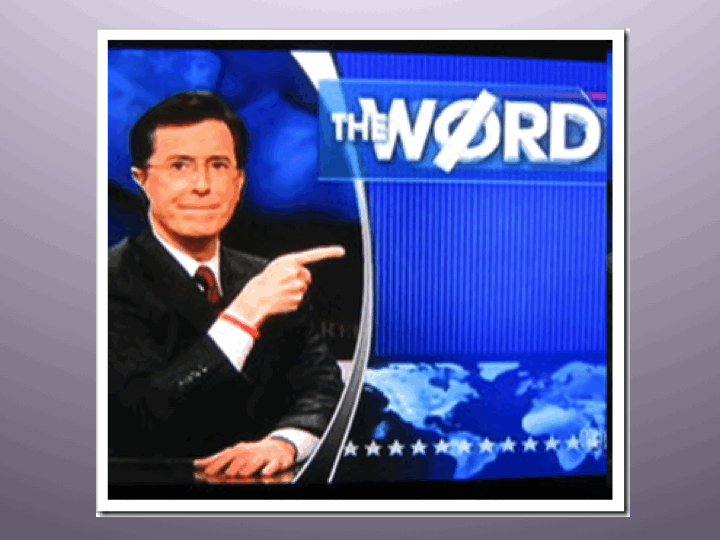
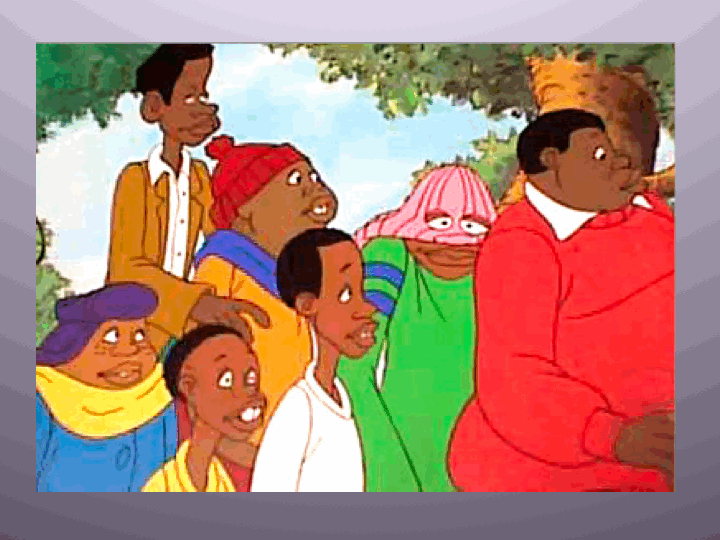
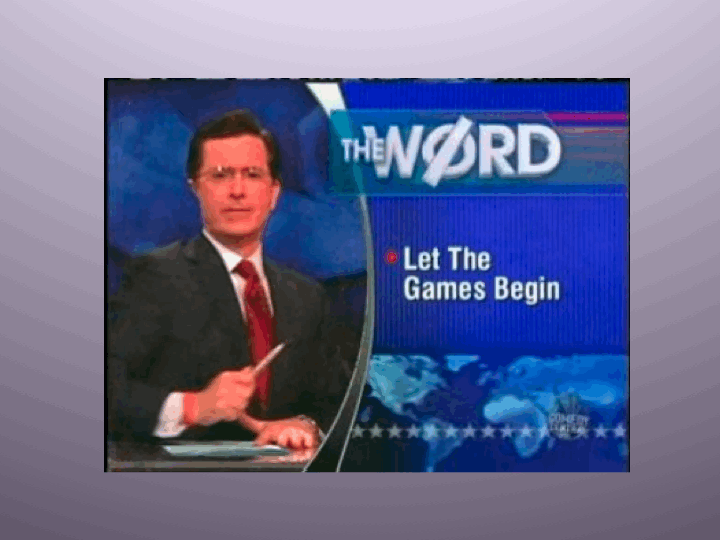
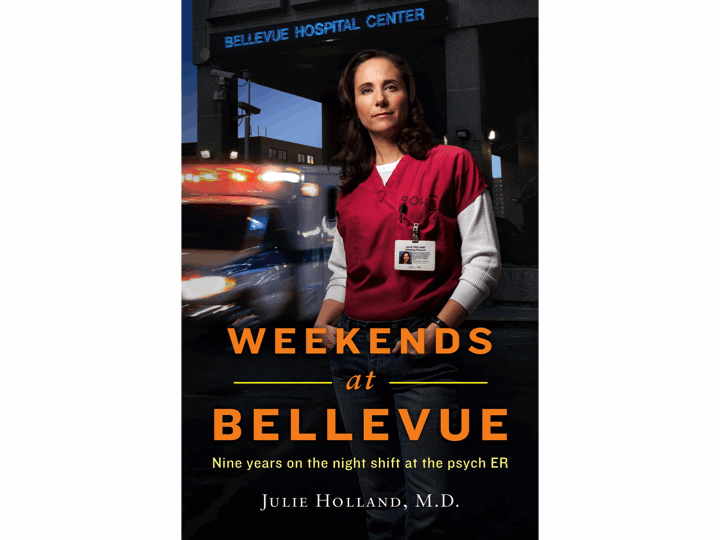
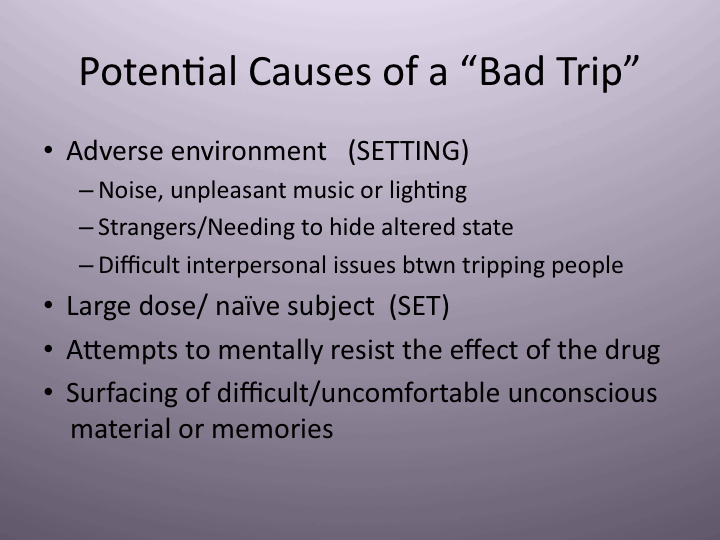
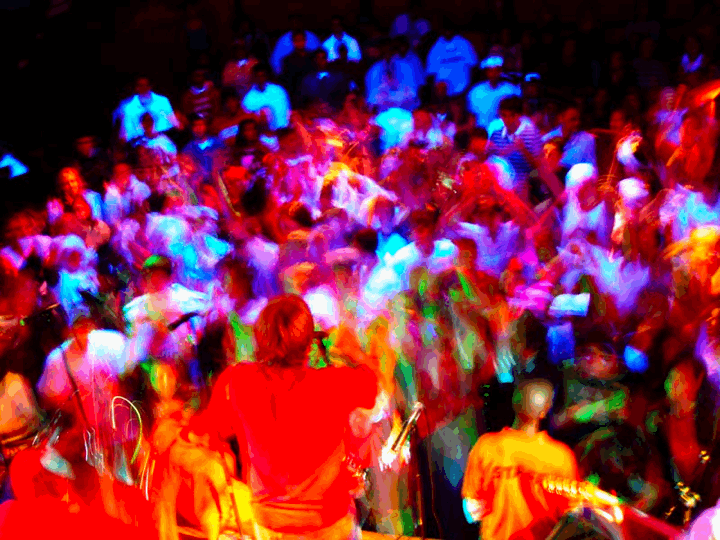
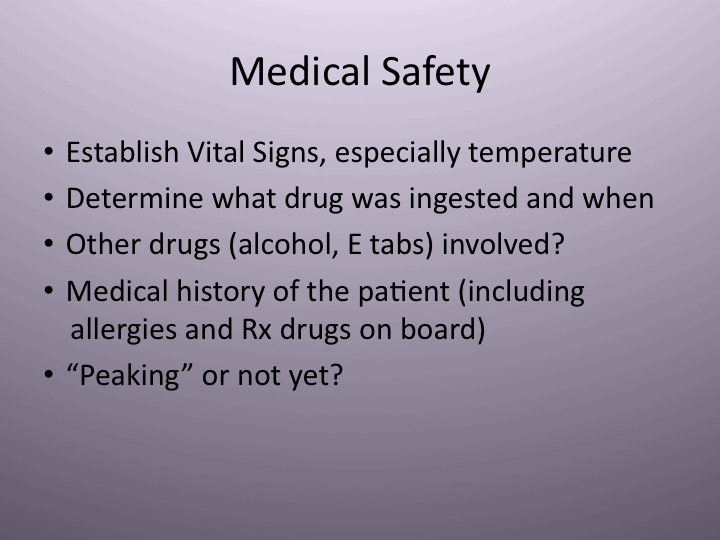
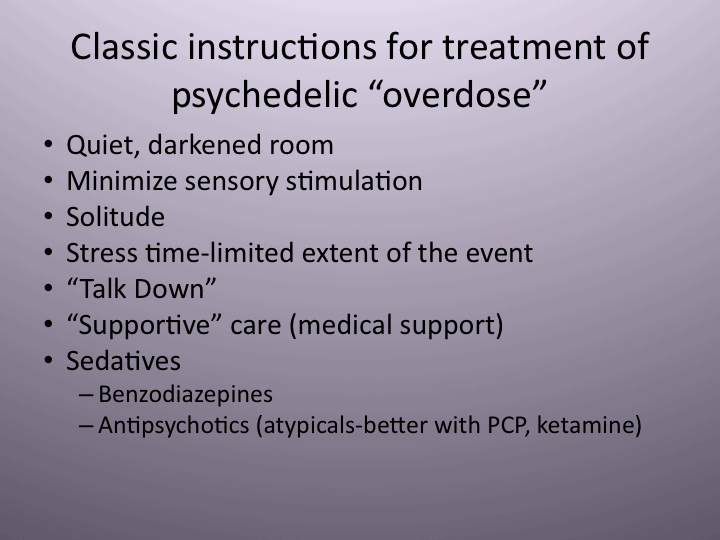
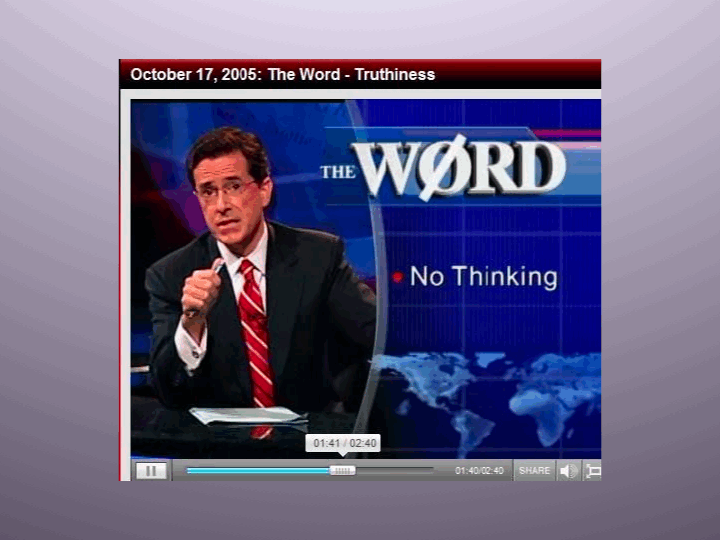
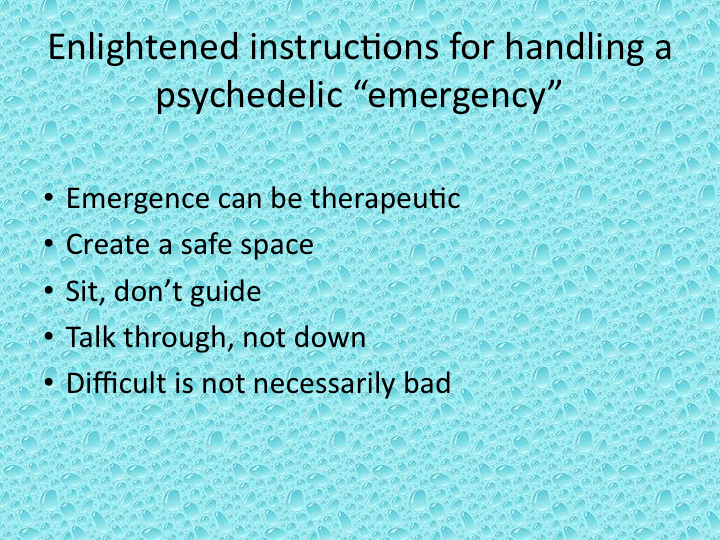
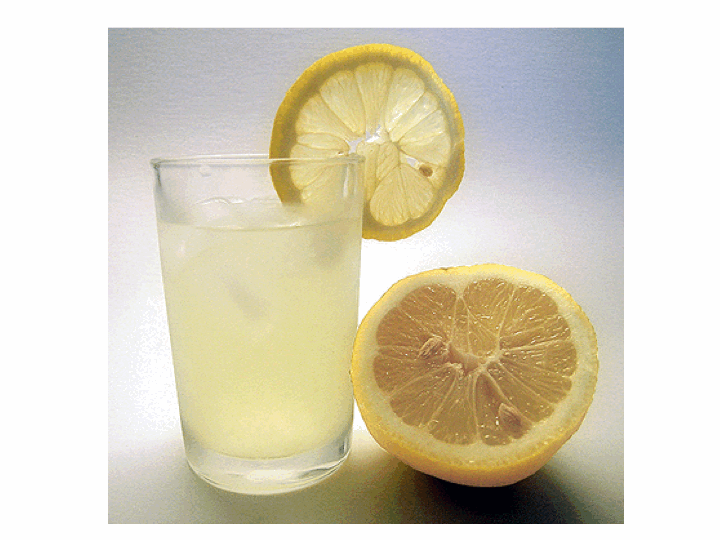
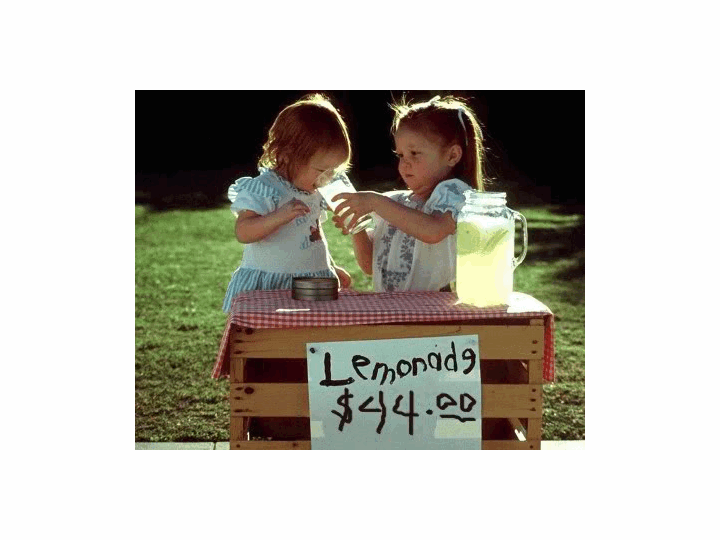
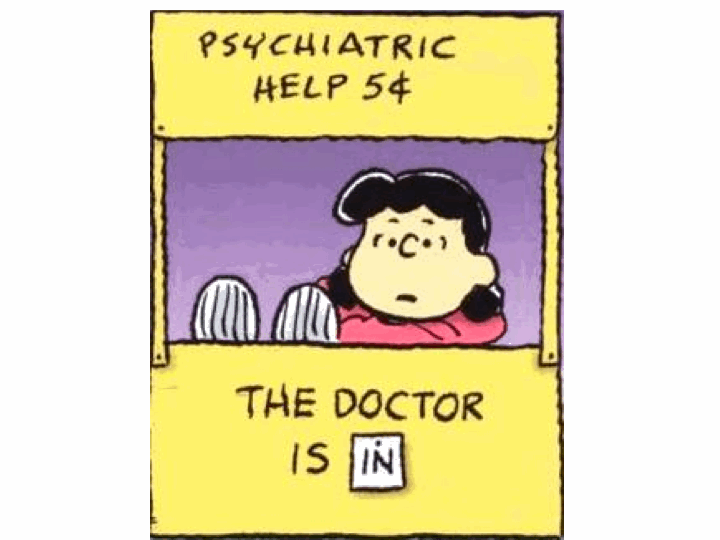

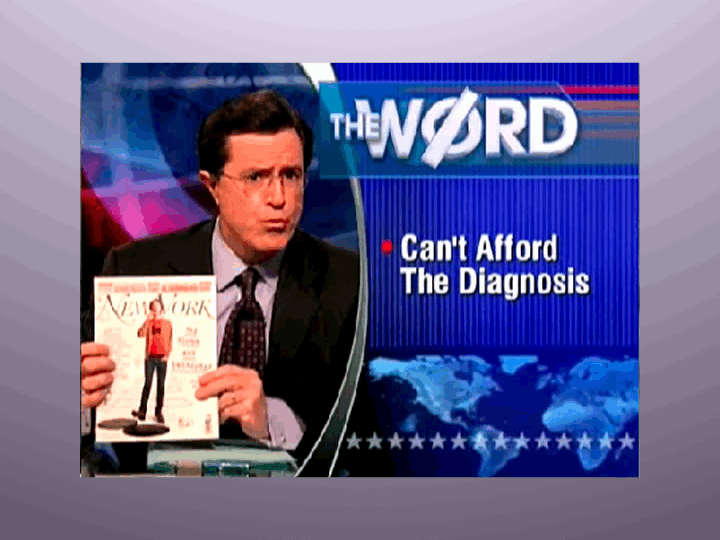
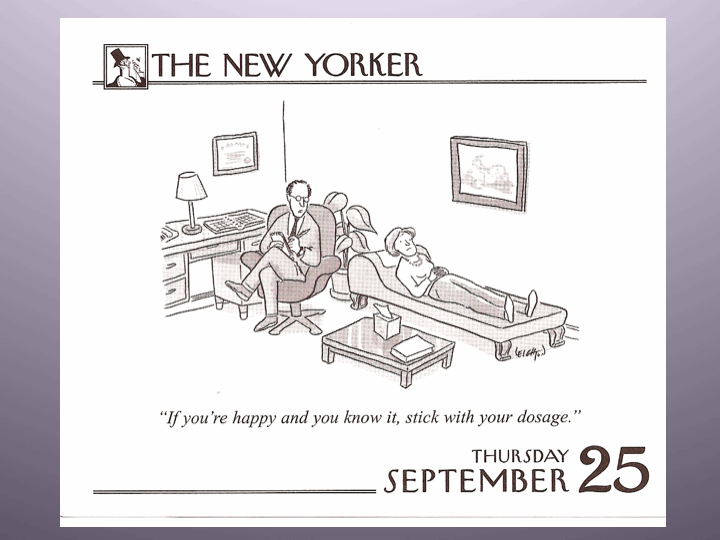

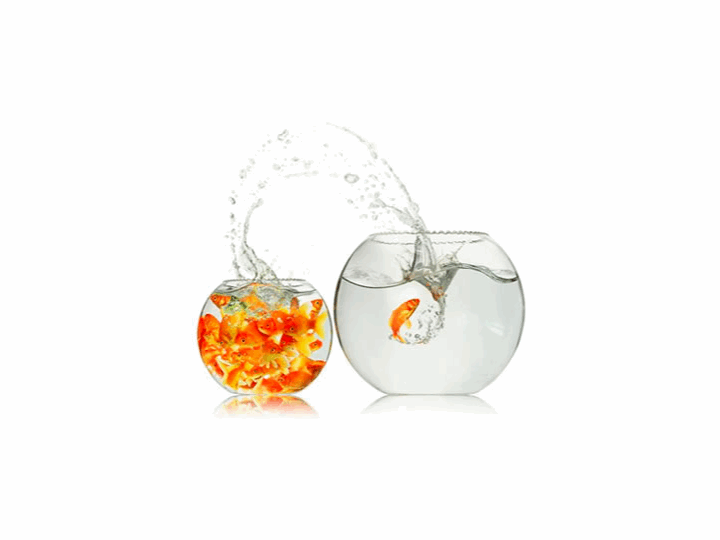


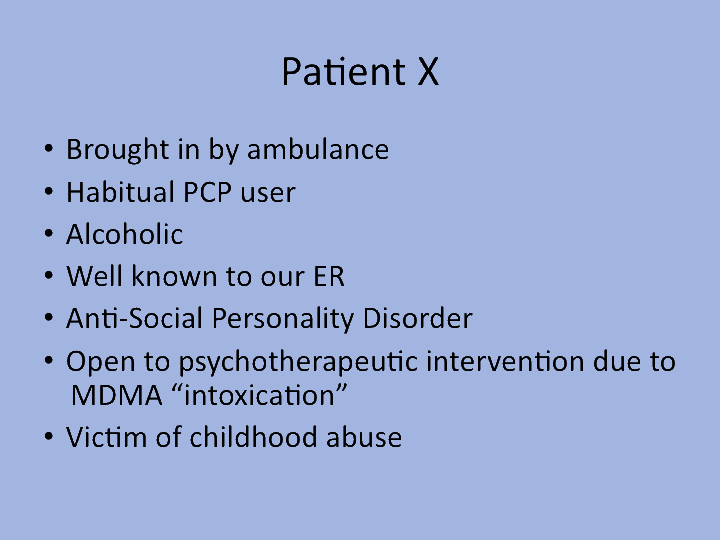
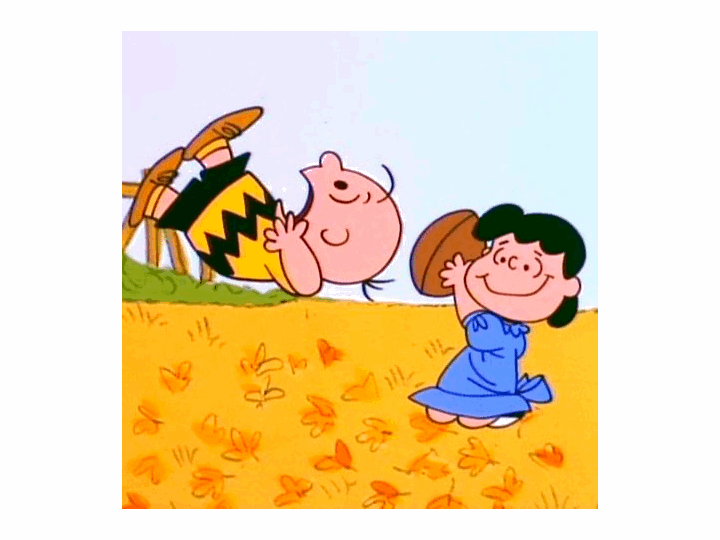
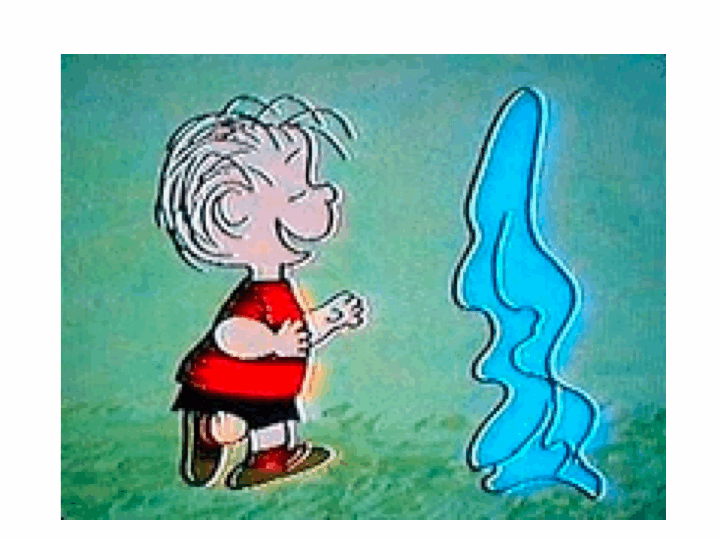

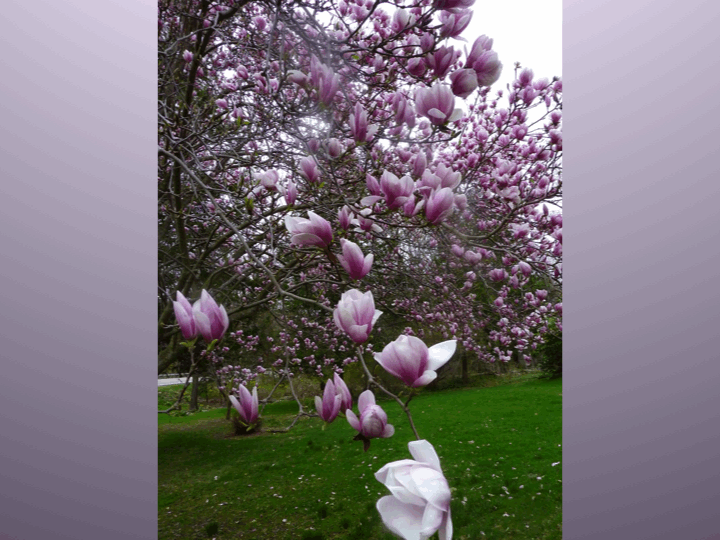

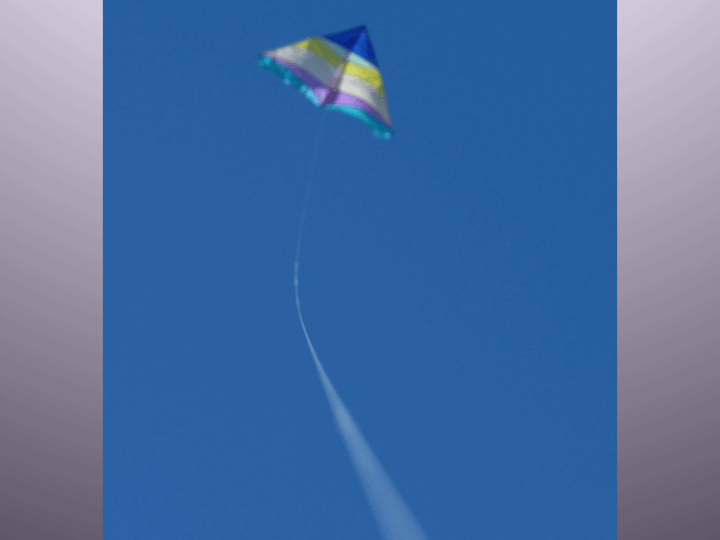
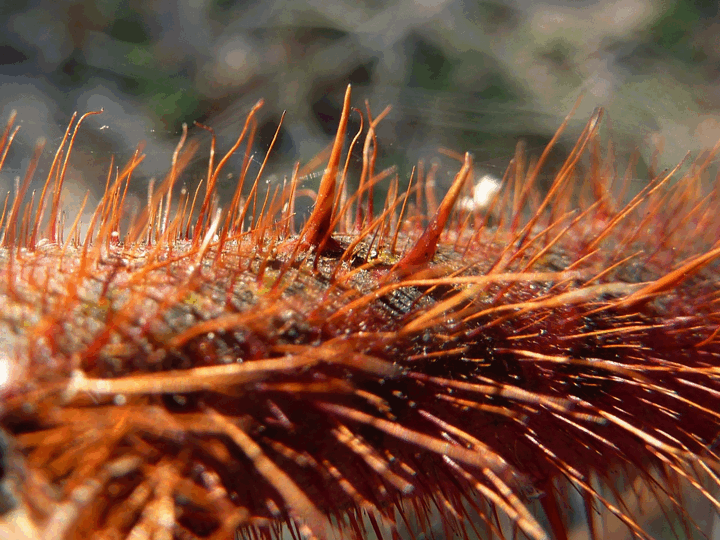
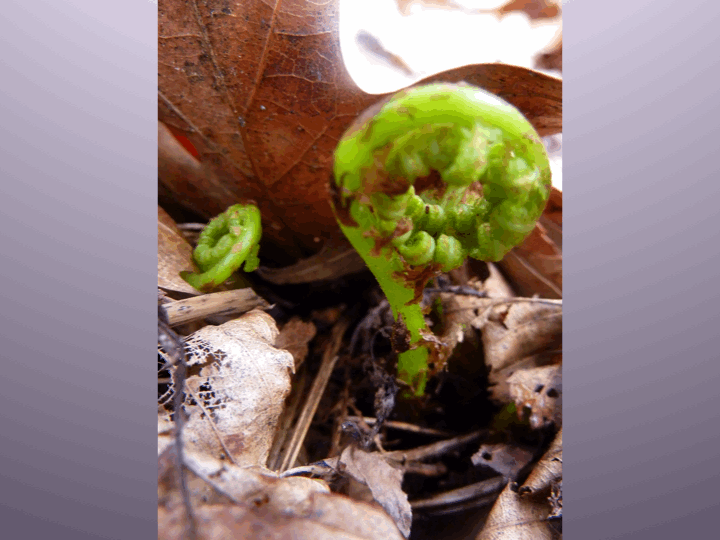
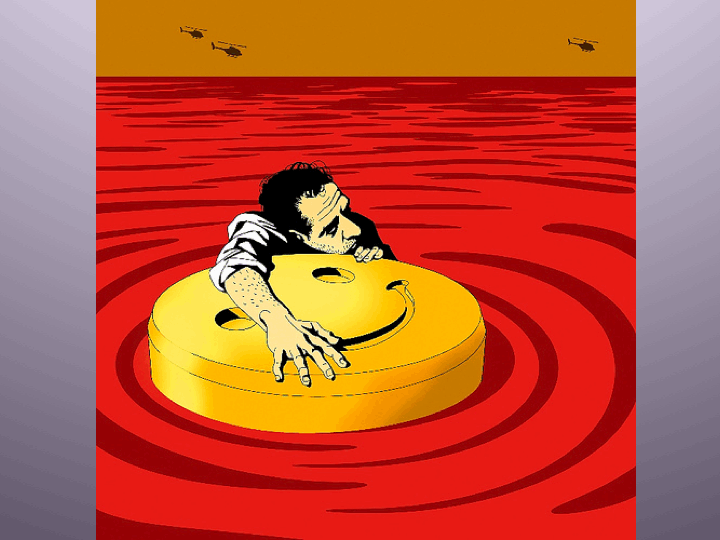
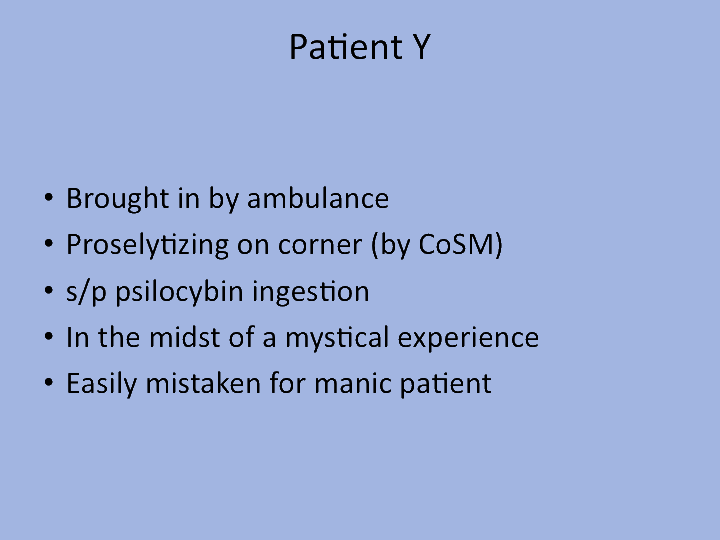


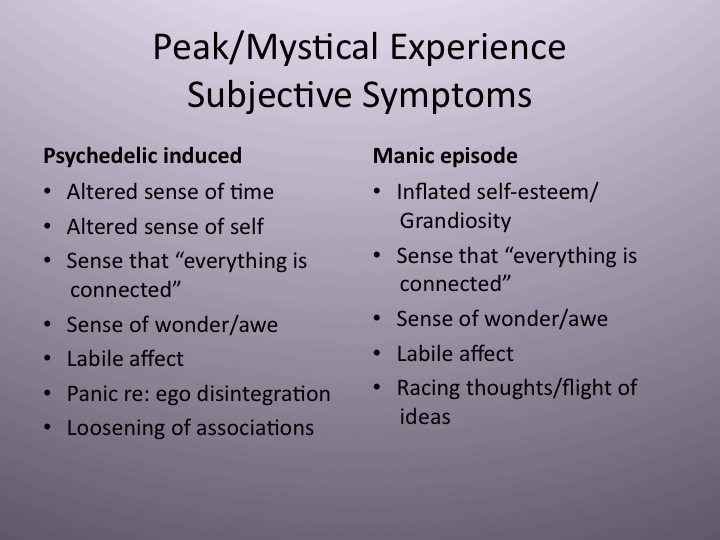
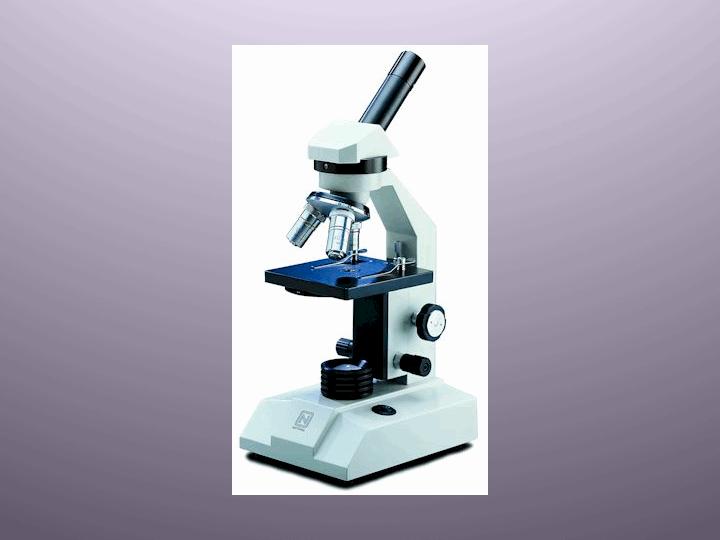
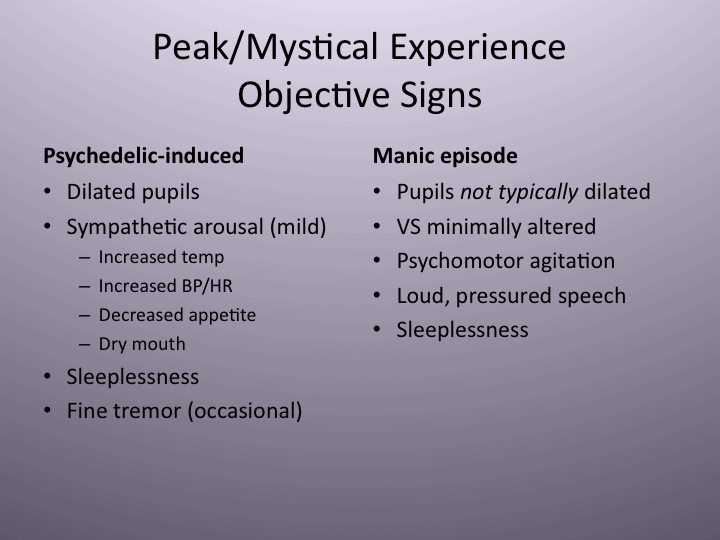
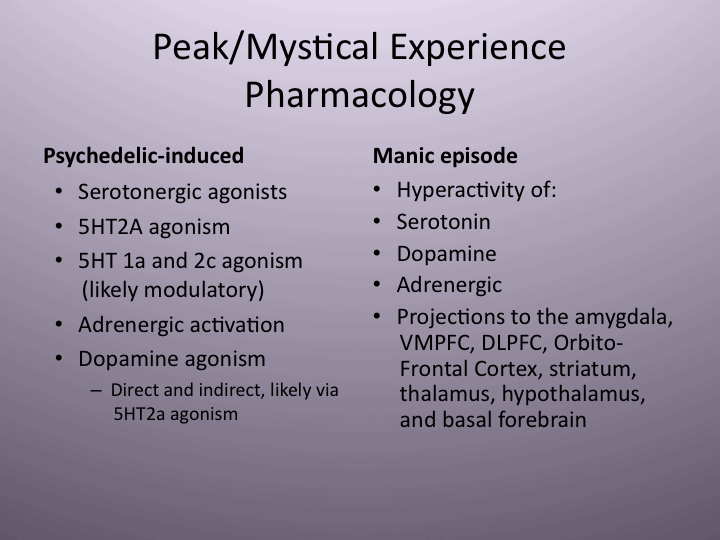
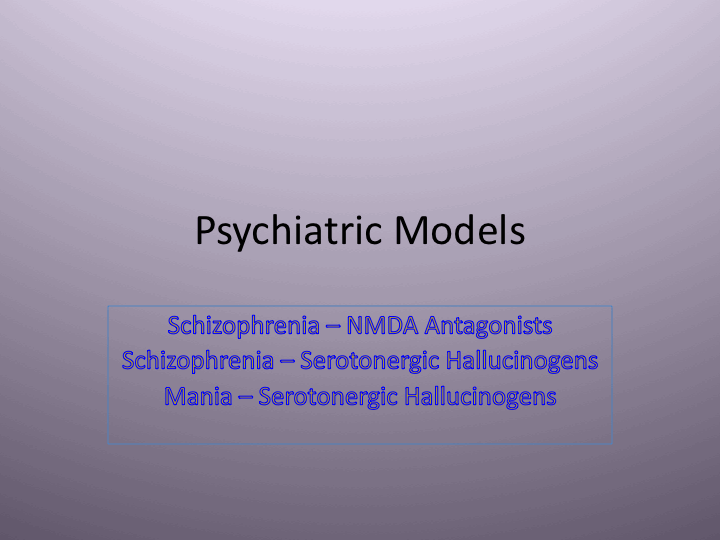
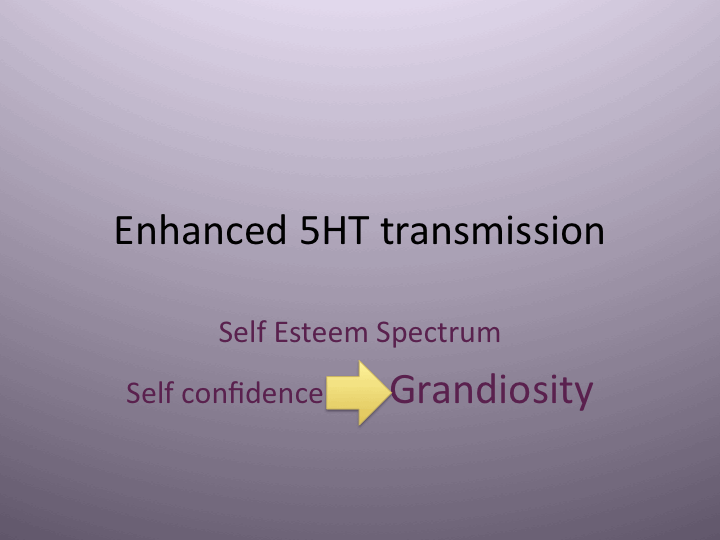
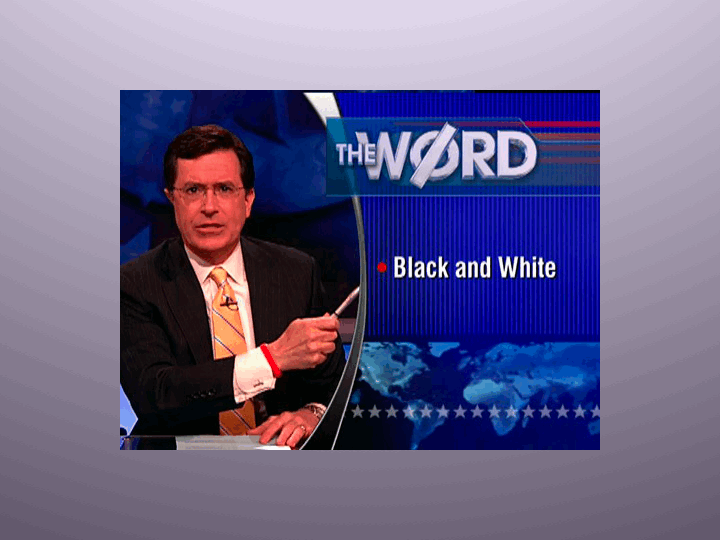
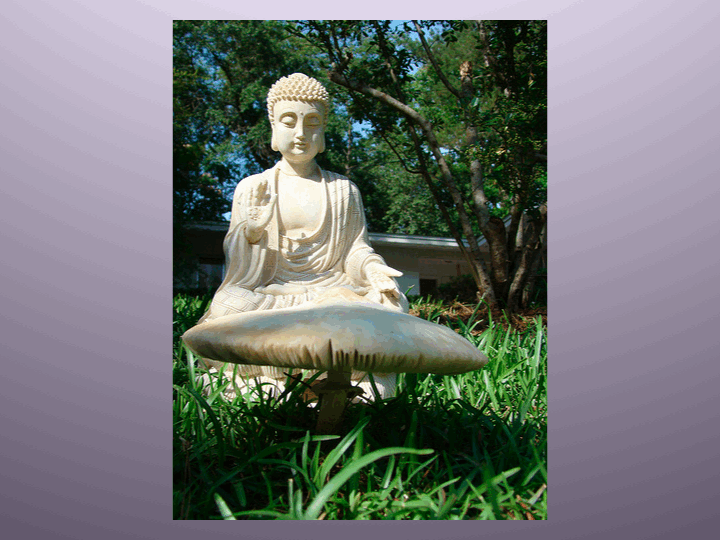
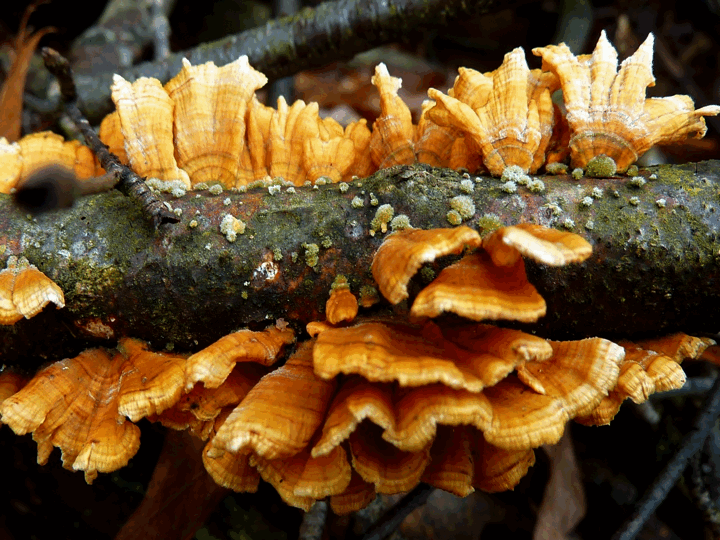
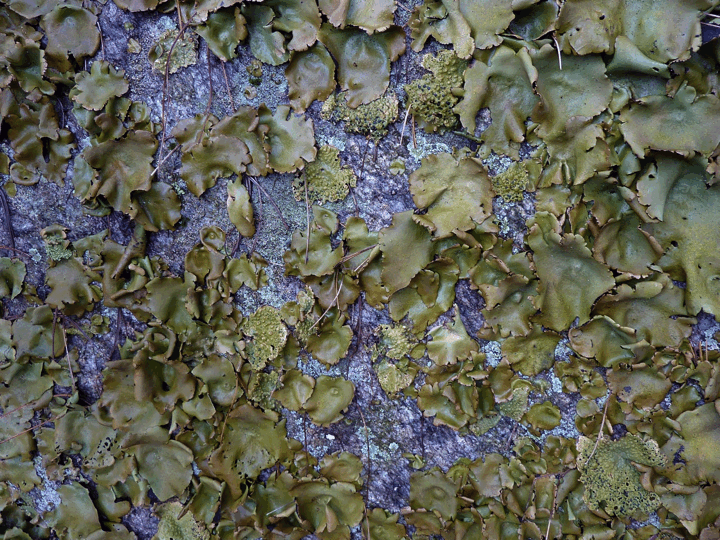

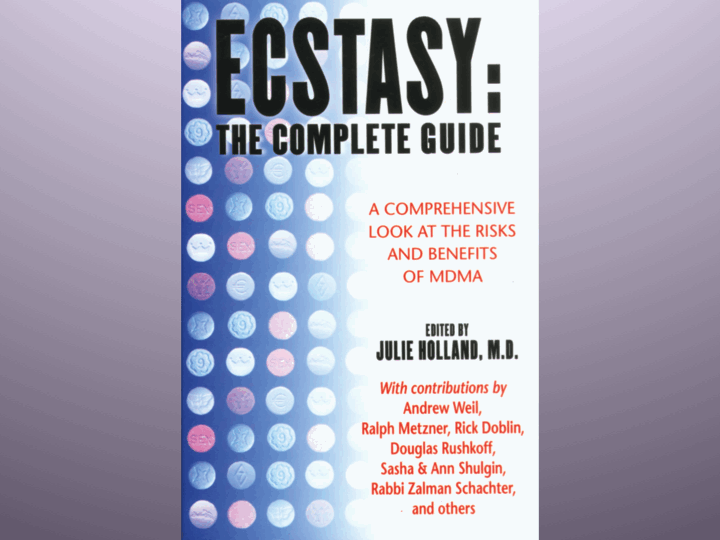
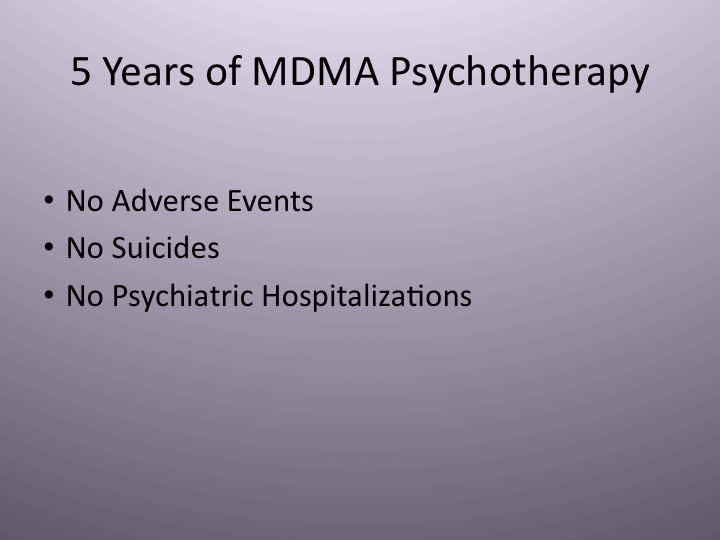
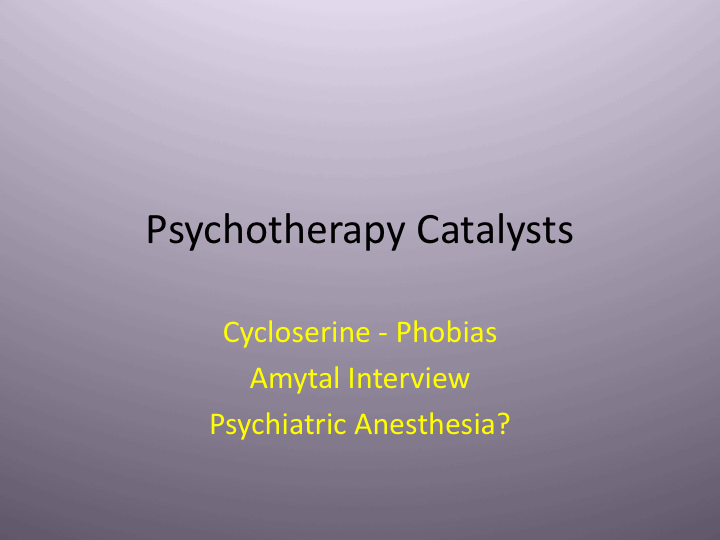
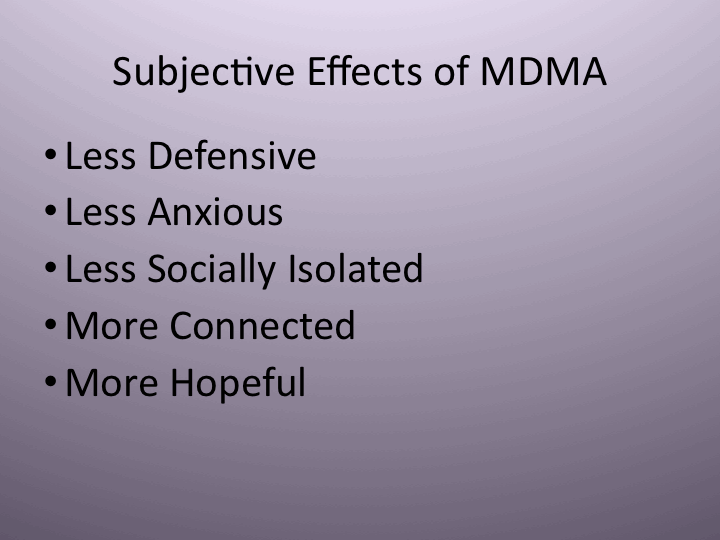
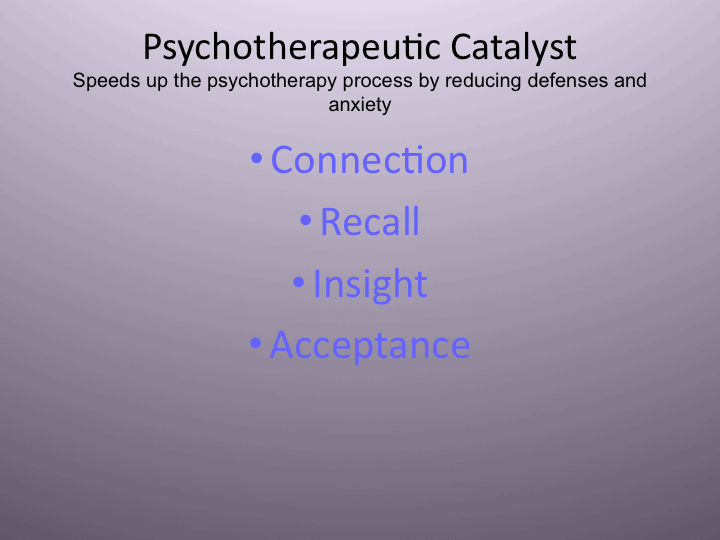
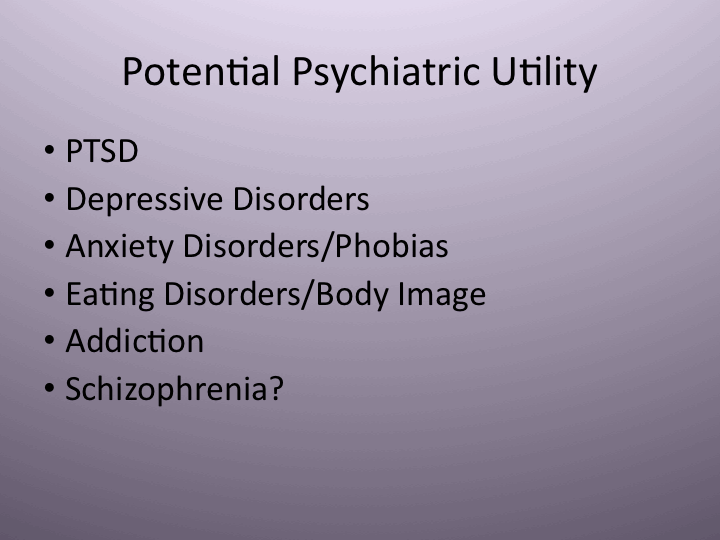
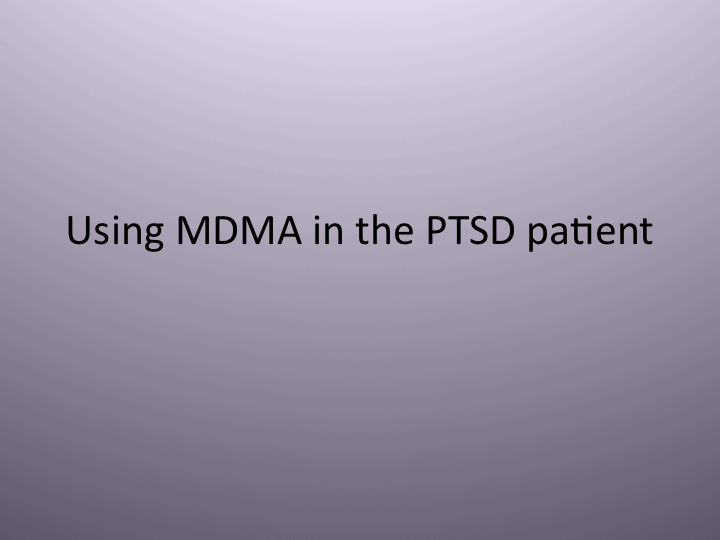
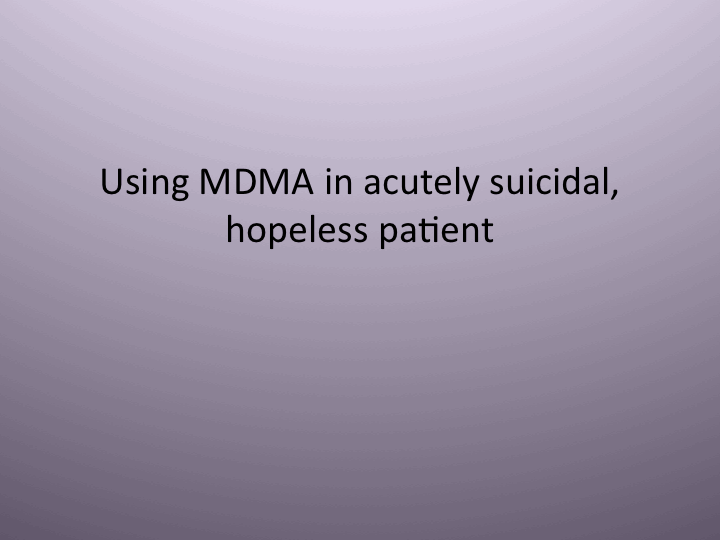

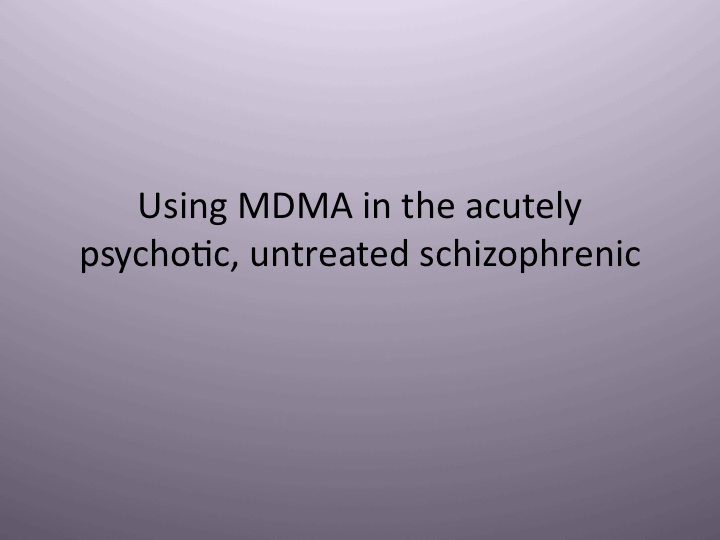
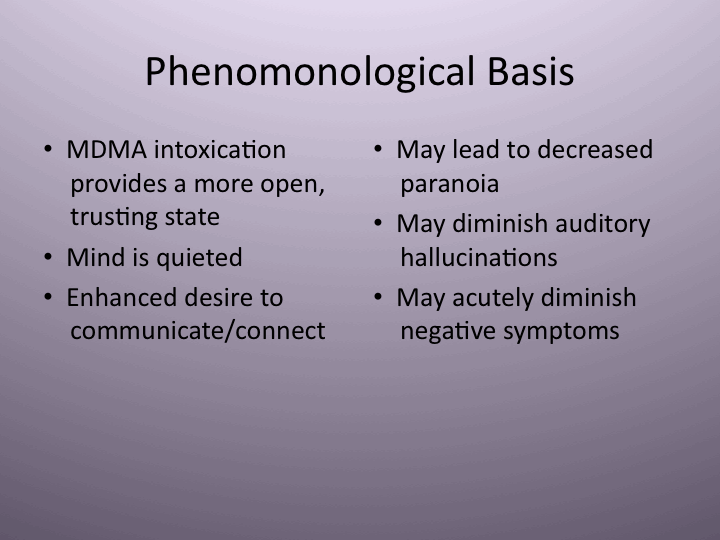
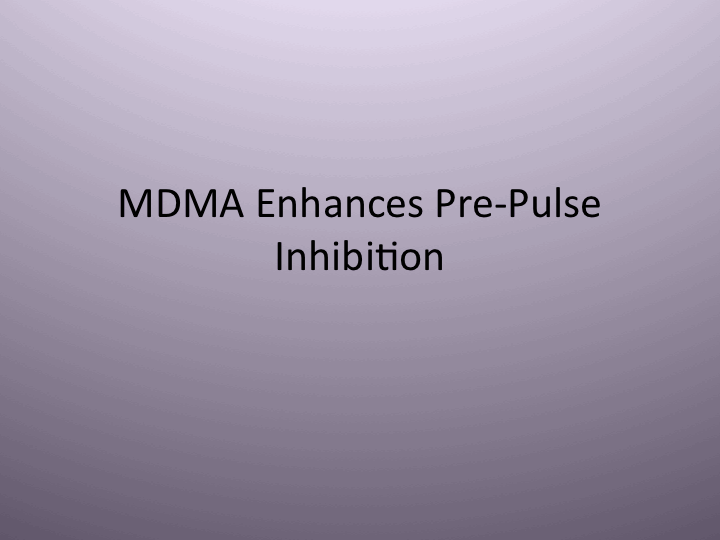
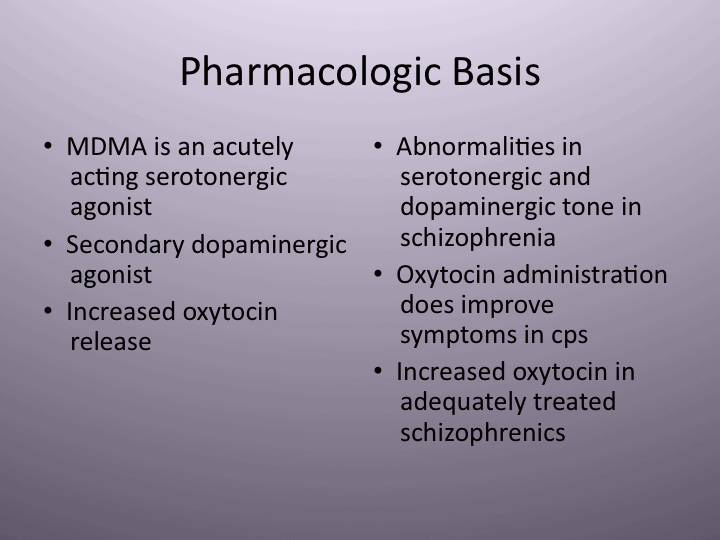
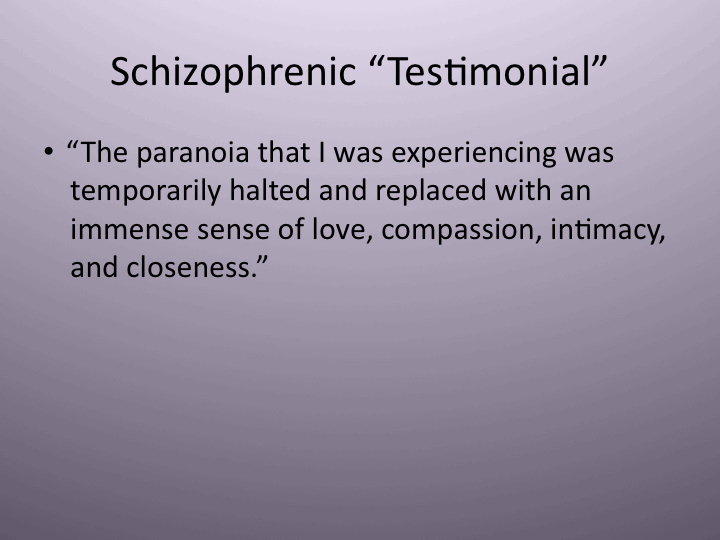

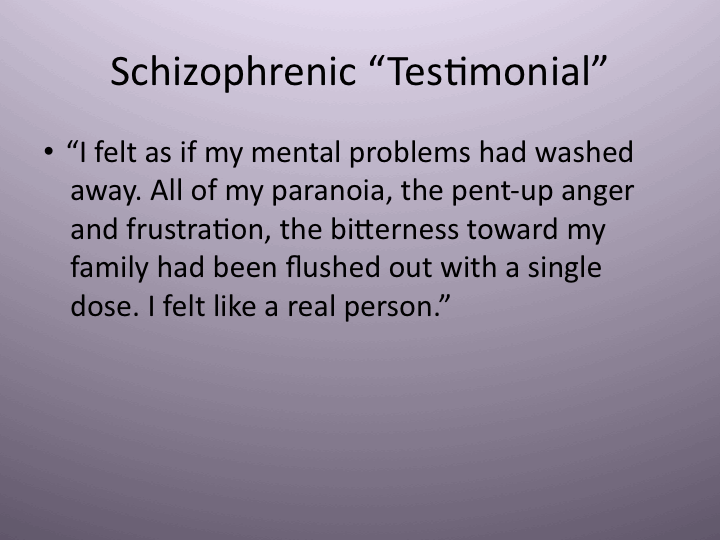
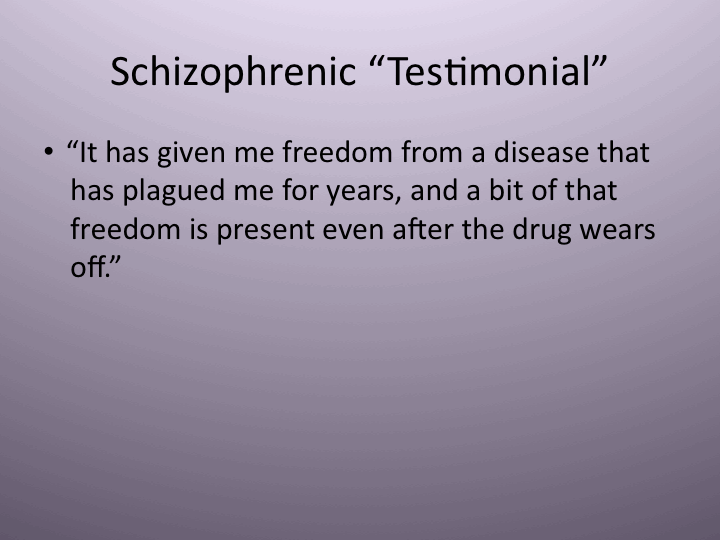
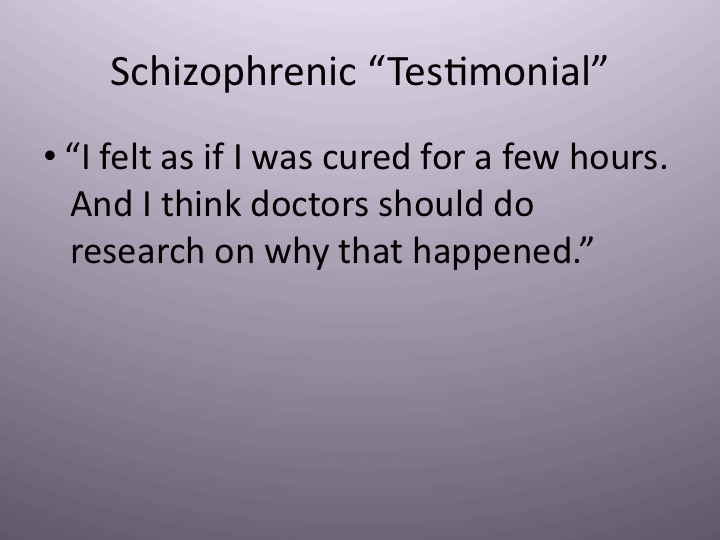
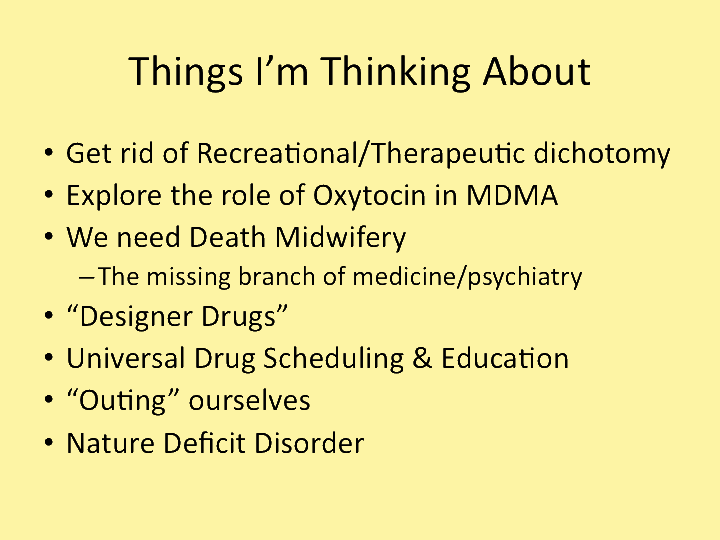

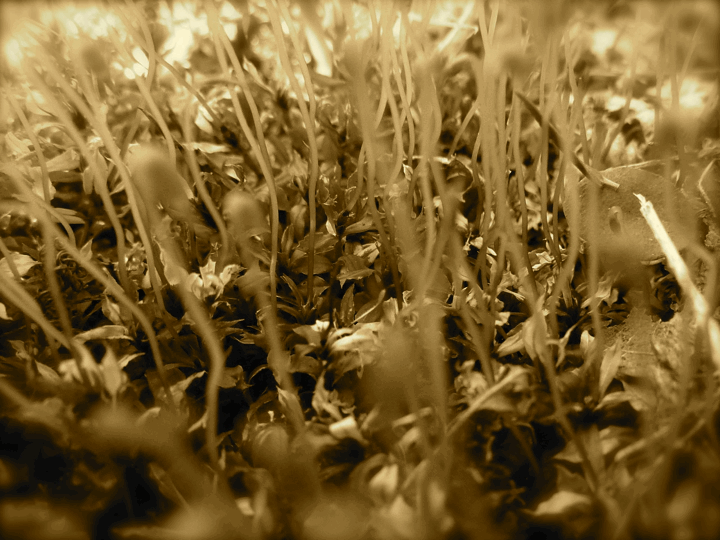

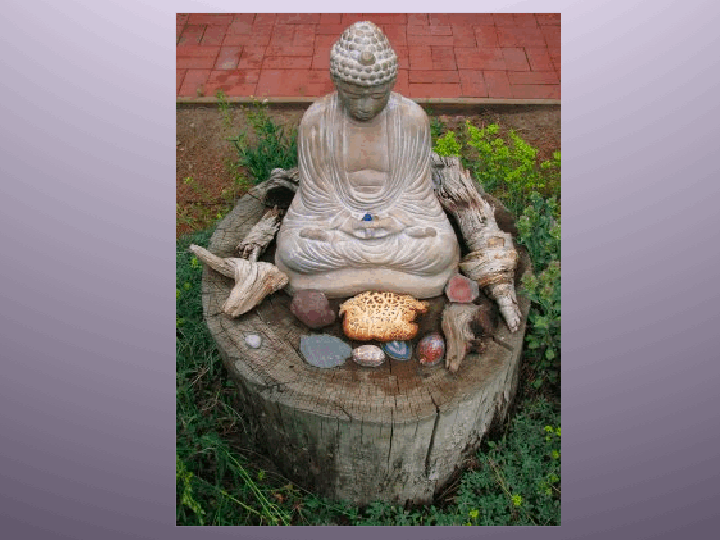
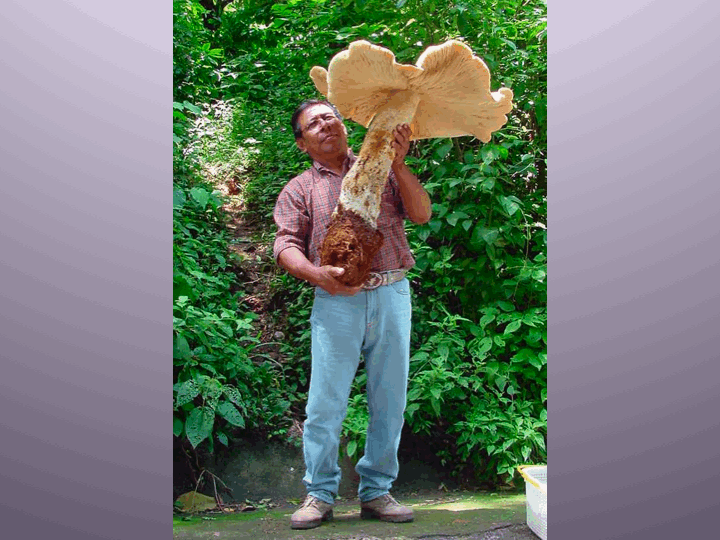
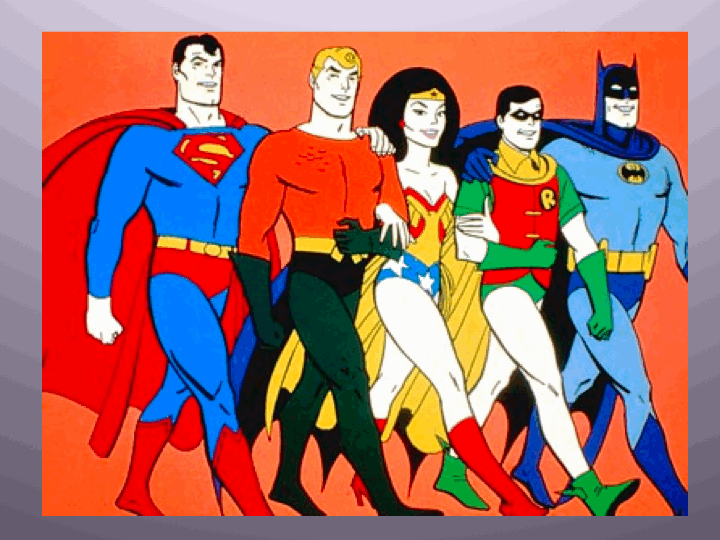
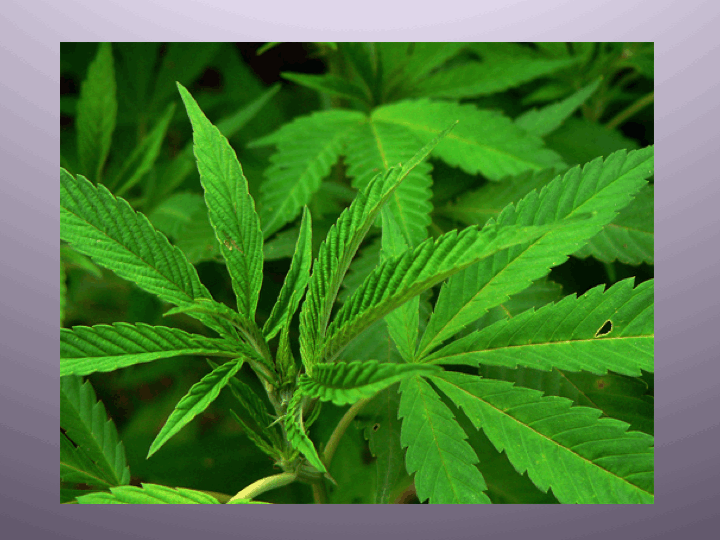
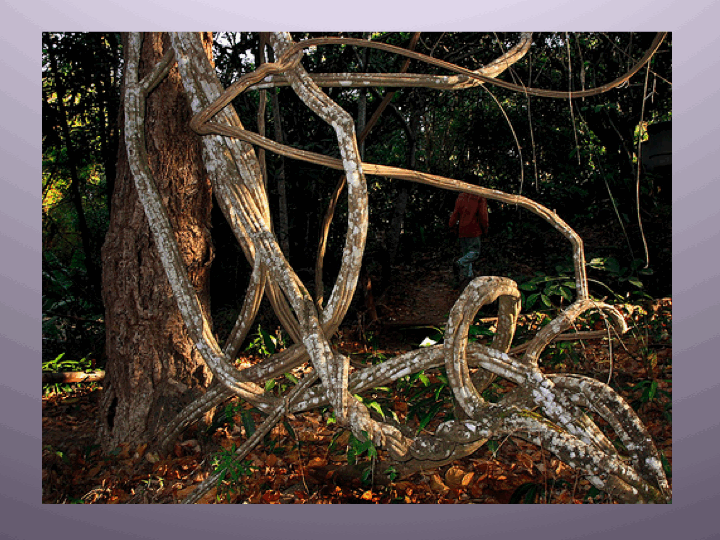
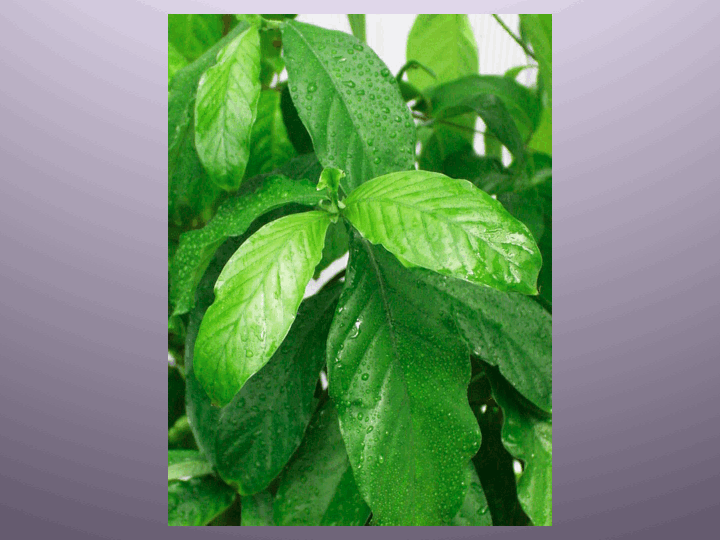
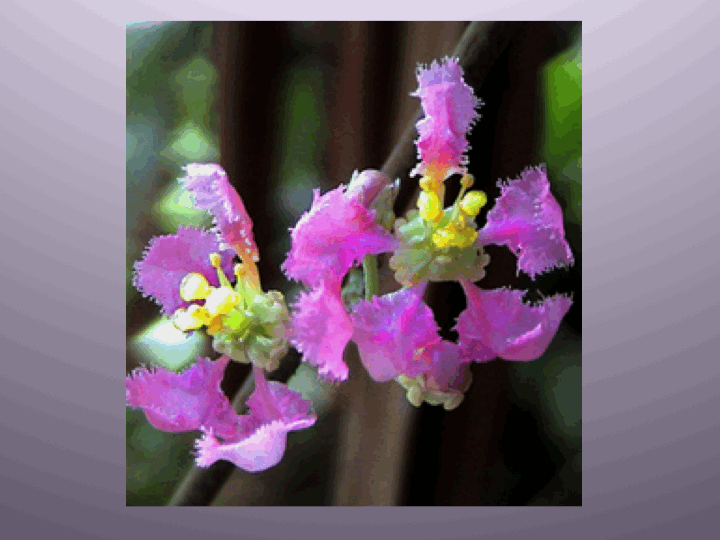
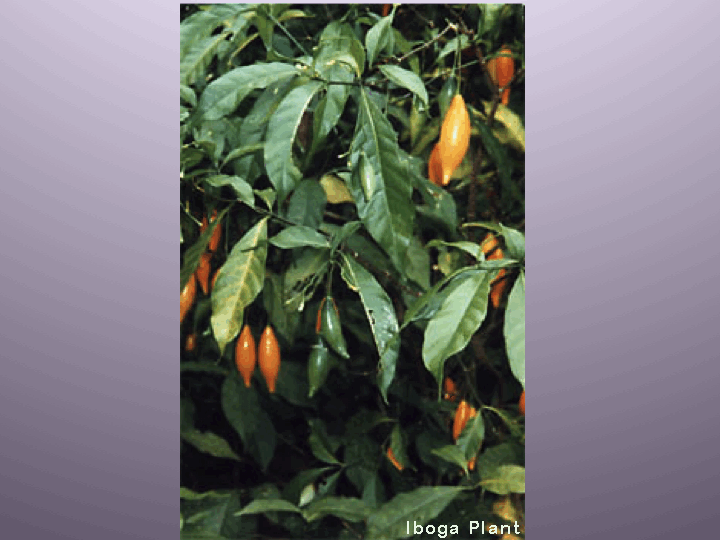

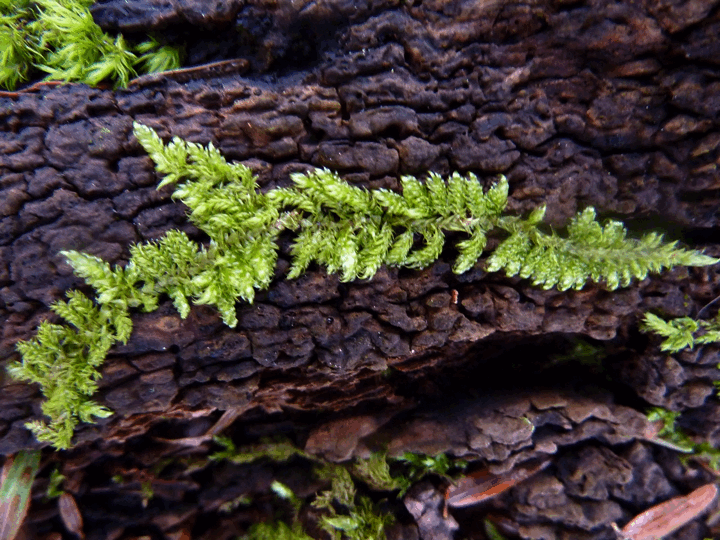
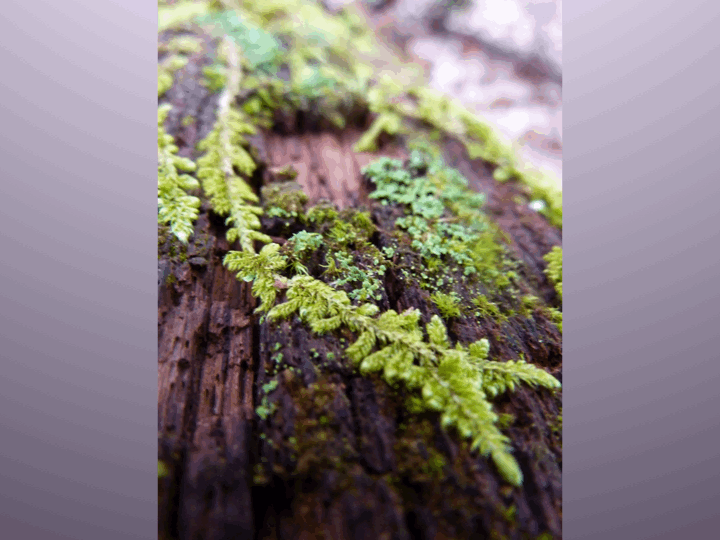





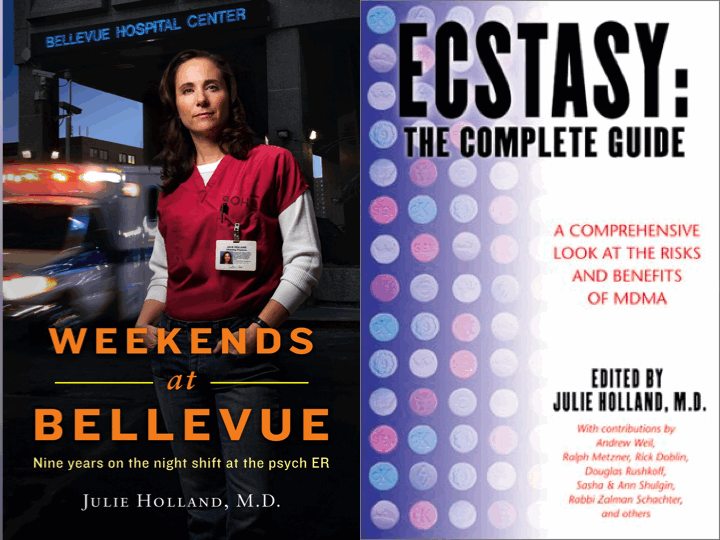
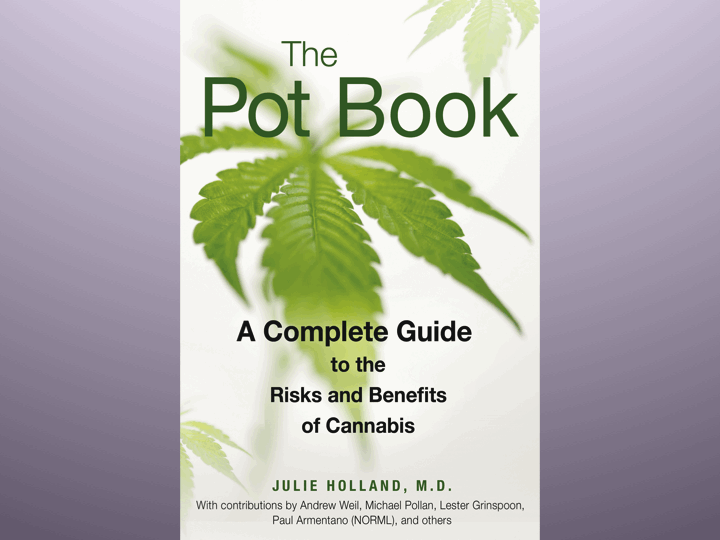
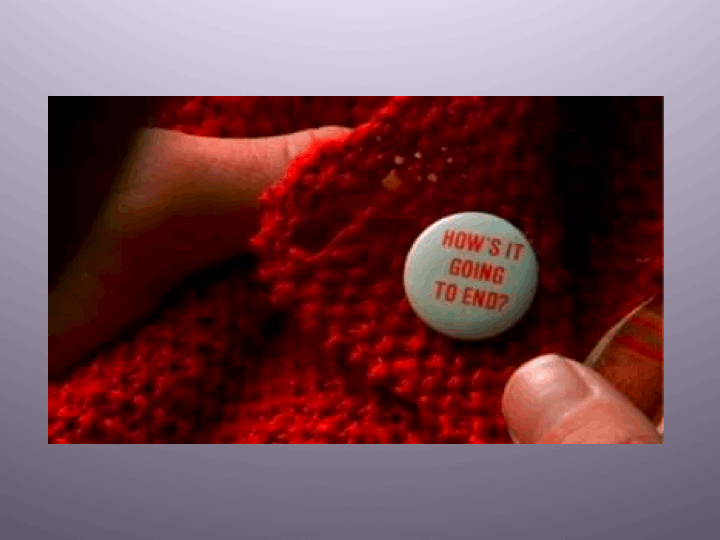



I worked at Bellevue's Comprehensive Psychiatric Emergency Program (CPEP).

I'm not a big fan of PowerPoint, and I was hoping to just come up here and speak to you all about some things I've been thinking about lately, and conclusions I've drawn after my nine years running the psych ER at Bellevue; but I was told I needed to do a PowerPoint presentation to make this CME worthy. I'd just like to say for the record, I'm against it!

Also, since it is Saturday morning, I thought I should include some cartoons here and there, so keep an eye out for that.

And now, without further ado!

Hey, buy my book wouldja? I spent nine years running the psych ER at Bellevue on Saturday and Sunday nights. I have seen thousands of patients in acutely altered states, whether induced by drugs or by endogenous means.
Every single shift I worked, I would be face-to-face with people in acute manic episodes, schizophrenic breaks, or horrible suicidal depressions. I saw people strung-out on methamphetamine, high on crack, drunk, stoned, and tripping. But I have to tell you, the rarest of all was tripping. Alcohol is far and away the drug that wreaked the most havoc at Bellevue. Because I got so familiar with what mania looked like, and from my own knowledge and experience with psychedelics, I started to notice a similarity to these presentations, manic episodes and psychedelic intoxications, which I'd like to touch more on in a moment.
Every single shift I worked, I would be face-to-face with people in acute manic episodes, schizophrenic breaks, or horrible suicidal depressions. I saw people strung-out on methamphetamine, high on crack, drunk, stoned, and tripping. But I have to tell you, the rarest of all was tripping. Alcohol is far and away the drug that wreaked the most havoc at Bellevue. Because I got so familiar with what mania looked like, and from my own knowledge and experience with psychedelics, I started to notice a similarity to these presentations, manic episodes and psychedelic intoxications, which I'd like to touch more on in a moment.

If a person is in crisis secondary to a psychedelic substance, here are some of the potential components of what has created that crisis: Choosing a bad setting (or having one befall you) for the experience to take place; being unprepared (poor set); trying to control the altered state instead of letting it have its way with you; and the most important element, I believe: what comes bubbling-up into consciousness courtesy of the catalyst ingested.

Just looking at this makes me feel like I'm having a bad trip. Not necessarily the optimal setting for psycho-spiritual exploration, eh? But a very popular one, nonetheless.

In an emergency room setting, medical safety needs to be established first and foremost. However, in general, because psychedelics tend to have large therapeutic indexes, there are rarely medical emergencies related to psychedelics. PCP (which is an anesthetic, not a psychedelic) can cause some medical problems. MDMA is an issue in terms of hyperthermia or water intoxication; but optimally, the medical ER would be handling this, not the psychiatric ER. From a toxicology point of view, it's helpful to know exactly what was ingested and when; but with our drug policy, the what is often impossible. Contaminants and counterfeits make it harder to ensure medical safety. Estimating whether the peak has occurred or yet is just a way to establish the timeline of what we're dealing with here.

The classic instructions are to put folks having bad trips in a quiet darkened room, and tell them it'll be over soon. Near universal recommendations of benzos, rare mention of antipsychotics, but we've all heard of people being given thorazine back in the day. Combining antipsychotics with PCP can cause anticholinergic delirium and akathisia. Atypical antipsychotics are much better for PCP intoxication. PCP is an NMDA antagonist, among other things, and 5-HT2A receptor antagonists and mGLU2 receptor agonists are better at reversing PCP intoxication. Remoxipride, in particular, seems to do a good job. In terms of serotonergic hallucinogens, there is no real antidote, though benzos can certainly help to diminish anxiety and panic reactions, and there is talk of antipsychotics with serotonergic action being helpful.

At Bellevue, we didn't really do much in the way of psychotherapy, or even supportive therapy. The truth is, mostly what we did was medicate and sedate people so the area would remain quiet and less chaotic. If people refused medication, they were often restrained. I'm sorry to tell you this, but honestly, that was the M.O. in the psych ER. Most importantly, there is an absolute DEARTH OF INFORMATION and teaching when it comes to psychedelics in medical school and psychiatric residency. If it weren't for Erowid, we'd have no references available to us at all in the ER. My colleagues at NYU, Jeffrey Guss and Steve Ross, thankfully, devised a teaching program about psychedelics. I believe they'll be giving a lecture on that this weekend.

The real way to handle a psychedelic emergency is by listening, being present, and making space for whatever is coming up. The patient is opened up, like never before, and vulnerable to the influence of those around him or her. Shuttling patients to sit alone in a corner and waiting for the sedation to take hold is not making the best use of this situation.

The psychedelic state isn't something to be medicated away--sedated for the clinician's convenience and comfort. The psychedelic emergency is actually an opportunity, for the patient and the clinician. Obviously, given all the data from psychedelic research in the past, and the current study results, we know now there is a unique window of opportunity for real growth and change to emerge from this altered state. And the emergency room psychiatrist should be on the lookout for these windows, which are rare in the lifetime of a patient.

A patient in a psychedelically induced 'crisis' is in need of empathy and connection, not just reassurance that it will end soon. (I love the price of the product for sale here, though!)

I think Lucy needs to bump her rates. The psychiatrist in an emergency setting should make him or herself completely available to these patients. Anyone presenting with psychedelics on board should be a priority, not because of the medical danger, but primarily because in the psych ER, there is precious little healing being done. At Bellevue, certainly, it was mostly triage: figuring out where people needed to be, and getting them there.

And because there are ever fewer people with health insurance, with limited access to competent psychiatric care, there will be more patients using emergency rooms as their primary care facility.

Patients in lower socioeconomic brackets tend to use ERs as their point of entry into the medical field. This is equally true for a psychiatric ER and psych patients. When we get our patients, they are always in crisis. These are not well-visits, or preventative care check-ups, by any stretch. But a patient in crisis is an opportunity for real psychiatric intervention and education.

Unfortunately, in my private practice, and in most of America, the easiest thing to do is to keep someone on their meds; don't rock the boat. And big pharma is heavily invested in continuing this status quo. Direct-to-consumer advertising of antidepressants, in women's magazines, on the morning talk shows, is ubiquitous, and a billion dollar business.

And there are a lot of other psychiatrists like me, and general practioners, out there who are very quick to reach for their Rx pads. A full ten percent of Americans are now taking antidepressants. Thirty percent of women who mention stress, difficulty sleeping, or low mood to their primary care doctors leave the office with a Rx for an antidepressant, a sedative/hypnotic, or both.

Patients in a psychedelically assisted crisis, who present to the psych ER, are in need of serious one-on-one, if any good psychotherapeutic work is going to be done. That means they need a private room and one clinician. At Bellevue, we do have the staffing and space for this eventuality. Especially in a teaching hospital, with medical students, residents, attendings, nurses, psych techs, we actually do have the manpower to take the time and sit with a patient to help them process. And I would say we have a moral imperative to try our hands at healing, not just sedating. Instead of squelching the experience, use it as an opportunity to midwife some very difficult emotional experiences into consciousness.

Primarily what is required is for the patient to debrief, unload, and otherwise try to verbalize their experience, hopefully with a measure of acceptance of the history and compassion for the self.

Here is an example of synesthesia. What can be immensely helpful, certainly it was in my case, is for the clinician to have some sense of what the patient is going through. I applaud the idea of psychotherapists, psychiatrists, and other clinicians being well-versed in the psychedelic experience. I believe it is invaluable in creating empathy, and in allowing the clinician to remain calm and centered, not suspicious of the altered state due to fear of the unknown.

This is a case report that I wrote about in Weekends at Bellevue. The chapter is called "Across the Universe". (I like the Beatles.) This patient was a very large, muscle-bound, tattooed meaty thug of a guy, well known to our psych ER because he typically came in high on PCP--very scary, aggressive, loud, and exquisitely paranoid. I had gotten to know him from previous visits, when he was often smelling of alcohol and very abusive, threatening to staff, and intimidating.
But this one time, he was brought in and he was a completely different guy. Smiling. Quiet. Good eye contact. Approachable. Turns out he had ingested some ecstasy tablets. It was a golden opportunity for me, and I was excited at the prospect of being able to do actual therapeutic work with him, instead of the usual sedation/restraint that we'd done in the past. It afforded me the chance of exploring his past, and his childhood, and I made the assumption that he had been the victim of sexual abuse, and asked him outright about it, which he confirmed. And we took it from there.

Uncovering repressed memories, especially of childhood abuse, is often where the money is. The bottom line here is that every childhood has trauma. No matter how idyllic the childhood, there are still things that wound and scar the soul. If you can gently unearth those traumas, and help the patient to process them, real healing and behavioral change can result.

One thing that I've found crucial is for the patient to identify what makes them happy, makes them feel love and loved, and gives them joy. For the patient to understand they have spiritual appetites as well as gastronomic and sexual appetites. To help them see that there are other things besides liquor, crack, and whores that can satisfy their longings. Psychedelic experiences are often replete with mystical and religious epiphanies, and 'a-ha!' moments that can lead to real behavioral change. Finding healthier substitutes for self-destructive behavior is one worthy goal in these sessions.

Many psychedelic-assisted experiences can help the patient to get a better sense of the big picture. Like in a video game, where you can pull out to the macro to see where you are, to see an aerial view...

and possibly be met with the sense that you're not quite as alone as you thought.

Getting a handle on the macro can help the patient to see where they've been, where they've gotten stuck, and how they've been going around in circles bumping up against the same obstacles.

By seeing the big picture, and the patterns, it may be easier to become unstuck, to break out of the ruts of repetitive self-destructive behavior. That is absolutely what happened with Patient X, who ended up leaving NYC and moving down to Texas to be with his girlfriend and child.

Patient X was a very prickly, scary, mean thug. I would've thought nothing could change that. He was the kind of patient that most psychiatrists consider un-fixable. Un-workable. And he would never let anyone in enough to even try it, until he happened upon that MDMA.

But with the right psychedelic, and the right attention, something magical happened that night. And if he were restrained and medicated, the way he was every other time he showed up at the ER, we never would've had the chance to really help him. Treat him. And heal him.

We've all heard about the promising results happening in MDMA posttraumatic stress disorder (PTSD) studies. My patients at Bellevue reminded me of veterans of domestic wars, a lot of the time. And most of the time at work, we were patching them up and sending them back to the front. MDMA, for some people, has the potential to be a real lifeline, an opportunity for growth and change. I was thrilled that Patient X happened to stumble upon this himself--though optimally, this would have been in a medically monitored, controlled setting, with a known quantity of a drug with known purity.

This second patient, also detailed in Weekends at Bellevue, was a young man in his mid-twenties brought in by ambulance from a street corner in Chelsea, giving his money and wallet and watch away on the street, encouraging passersby to divest themselves of their worldly possessions as well. In the ER he was proselytizing, with hyper-religious speech, and he seemed to not be oriented to place or time. He looked exactly like many of the manic patients we receive by ambulance. But he happened to mention CoSM, the Chapel of Sacred Mirrors, and I happened to hear him. And when I asked him about drugs, he told me he had eaten mushrooms.

Luckily, I had been to CoSM, and I knew how intense an experience that can be, never mind the mushrooms. I'm glad I was on shift that night, because with a story like his, many other attendings would've assumed he was manic, medicated him and admitted him upstairs. I sat with him and talked, helping him to navigate his trip: coming down in a grungy city ER with no money, ID, or way home.

One thing I noticed during my nine years at the psych ER was how certain patients reminded me of my tripping high school friends. Patients in a manic episode were often describing their thoughts and ideas to me, and many of them spoke to me about religious epiphanies, a felt oneness with the universe, feeling enlightened, everything suddenly made sense. There was this sense of wonder at the universe, a sense of awe, how everything was connected. The boundaries between self and other dissolve.
There is something called the 'Experience of the Immanent Divine'. To quote Stan Grof, 'A person having this form of spiritual experience sees people, animals, plants, and inanimate objects in the environment as radiant manifestations of a unified field of cosmic creative energy.'
This can happen during a psychedelic experience, or during a mystical, holotropic experience, but I am here to tell you it absolutely happens in a manic episode. I've seen it repeatedly. And I love what Dr. Grof says about it: 'In a certain sense, the perception of the world in holotropic states is more accurate than our everyday perception of it.' It's like the William Blake quote: 'If the doors of perception were cleansed every thing would appear to man as it is, infinite. '
There is something called the 'Experience of the Immanent Divine'. To quote Stan Grof, 'A person having this form of spiritual experience sees people, animals, plants, and inanimate objects in the environment as radiant manifestations of a unified field of cosmic creative energy.'
This can happen during a psychedelic experience, or during a mystical, holotropic experience, but I am here to tell you it absolutely happens in a manic episode. I've seen it repeatedly. And I love what Dr. Grof says about it: 'In a certain sense, the perception of the world in holotropic states is more accurate than our everyday perception of it.' It's like the William Blake quote: 'If the doors of perception were cleansed every thing would appear to man as it is, infinite. '

There are many similarities between a religious epiphany or mystical experience, a peak experience engendered by psychedelics, and a manic episode. The expanded sense of space and time, the dissolution between self and other, the exaltation at finally understanding EVERYTHING. The labile affect seen in psychedelics and mania is very similar as well. It is easy to laugh, to cry, and to be deeply touched by something to the point of tears.
Psilocybin and LSD also can cause a loosening of associations, there's good work by Spitzer on this, and you see those same loose associations in manic speech. Making these broader connections, though, can be therapeutic, I think. And it's this sort of looseness of associations that helped certain people come up with the helical structure of DNA, or the idea for shareware. I'm a big fan of loose associations, actually. It's also fun to listen to people talk like this, watching how they jump from one topic to another and seeing how they got there.
Psilocybin and LSD also can cause a loosening of associations, there's good work by Spitzer on this, and you see those same loose associations in manic speech. Making these broader connections, though, can be therapeutic, I think. And it's this sort of looseness of associations that helped certain people come up with the helical structure of DNA, or the idea for shareware. I'm a big fan of loose associations, actually. It's also fun to listen to people talk like this, watching how they jump from one topic to another and seeing how they got there.

One of my favorite manic patients walked up to me in the detainable area and tapped me on the shoulder to explain something he'd just figured out. He said, 'We're all part of this huge experiment. We're all under a giant microscope. Do you know where the eyepiece is? It's what you call the sun.' It was hearing those kinds of things that kept me working at Bellevue year after year.

Objective signs between these two states don't help you much; they don't look exactly the same, but pretty close, except for the pupils. But I put 'not typically' in italics because I have definitely seen people in a manic phase who are in such a state of rapture and enlightenment, that their pupils were dilated. The 'telescope guy' absolutely had dilated pupils, but had taken no drugs.

While enhanced serotonergic transmission is definitely part of the psychedelic state, what is less simply defined is what underlies the manic episode. Serotonin is implicated, definitely; but other neurotransmitter systems and second messenger systems are also at play--ventromedial and dorsolateral prefrontal cortex.

The PCP model of schizophrenia is the best drug model for a psychiatric illness that we have right now, and it is admittedly a much better fit than the LSD/psilocybin model of schizophrenia or of mania. PCP does a good job inducing symptoms reminiscent of the whole spectrum of symptoms seen in chronic paranoid schizophrenia (CPS). PCP or ketamine cause negative symptoms as well as positive ones. (Thinking and talking less, as well as being socially isolated or ambivalent are negative symptoms; disorganized speech, ideas of reference, thought disorder, and auditory hallucinations are positive ones.)
Psychedelics, typically, don't cause auditory hallucinations or many other symptoms of CPS. But 5-HT2A activation does produce psychotomimetic effects. And there are 5-HT2A receptor abnormalities in brains of CPS. Clozapine and Risperdal have 5-HT2A antagonist properties and I think they're particularly good in schizophrenia. So there are some things that fit in the hallucinogen schizo model, definitely. But what I think also is a good fit is the hallucinogen mania model.
Psychedelics, typically, don't cause auditory hallucinations or many other symptoms of CPS. But 5-HT2A activation does produce psychotomimetic effects. And there are 5-HT2A receptor abnormalities in brains of CPS. Clozapine and Risperdal have 5-HT2A antagonist properties and I think they're particularly good in schizophrenia. So there are some things that fit in the hallucinogen schizo model, definitely. But what I think also is a good fit is the hallucinogen mania model.

One thing I think you can see in the psychedelic experience, and certainly in the MDMA-induced state, is a stronger sense of self: enhanced self-esteem and confidence. It's common to see a certain grandiosity produced by the serotonergic psychedelics, at times. Something akin to, 'I am God. I am all-powerful.' Feeling God-like and omnipotent is something you absolutely see in mania as well. There's a sense of exaltation, of expansiveness. My assumption is that these experiences are related to serotonergic tone.

This was going to be a great section with beautiful psychedelic-looking, colored PET slides of mania, prayer, meditation, and psilocybin, but the talk got too long.

We've seen how psilocybin reliably induces a mystical experience, courtesy of Roland Griffith's group at Johns Hopkins. What we're talking about here is a naturally occurring fungus, that has co-evolved with us on the planet for millennia, that helps humans get in touch with some sort of divine presence or universal connector, to help provide that 'we're all connected' type of experience.

These are some pictures my husband, Jeremy Wolff, took of fungus for me. You can see his artwork at very.com. This is a close-up photo of some fungus growing on a dead tree.

This is a very basic fungus, growing on a rock. No dirt. No organic material. Not many things will grow on a rock. But I believe, as you can see here, that growth is possible under any circumstances, with the right set of conditions. This means that even someone with antisocial personality disorder (ASPD), or chronic treatment-refractory PTSD, or intractable addiction, can grow and change and blossom given the right therapeutic conditions. There's a saying in chemistry, 'like dissolves like'. Maybe it takes a drug to help break the chains of drug addiction. That is certainly the case with ayahuasca and ibogaine.

Nearly every time someone presented to the psych ER in an agitated state they were given medications. Patients were routinely injected with 5/2/50 (5 mg haloperidol [Haldol], an antipsychotic; 2 mg lorazepam [Ativan], an anti-anxiety medicine; 50 mg diphenhydramine [Benadryl], a sedative). These days they're often given injections of atypical antipsychotics. These medications are not harmless. Antipsychotics carry the risk of irreversible neurologic illnesses such as tardive dyskinesia or irreversible metabolic disorders such as diabetes. If they're going to be medicated anyway, why not, instead of giving them something that makes them sleep for six to eight hours, give them something that allows them to open up, and voice some of their most pressing issues?
I don't want to belabor the point that psychedelics are, for the most part, non-toxic to the body, and that there is a potential for real emotional and spiritual growth, evaluation, and behavioral changes that can result. My point here is that there should be a way to incorporate spiritual healing in the psych ER. It is not uncommon to see patients who are having real psychospiritual crises, or spiritual emergencies. It may be possible, via medicines that help to occasion a mystical experience, to assist these patients more fully than how we have been doing it all along, by tranquilizing and sedating them.
I don't want to belabor the point that psychedelics are, for the most part, non-toxic to the body, and that there is a potential for real emotional and spiritual growth, evaluation, and behavioral changes that can result. My point here is that there should be a way to incorporate spiritual healing in the psych ER. It is not uncommon to see patients who are having real psychospiritual crises, or spiritual emergencies. It may be possible, via medicines that help to occasion a mystical experience, to assist these patients more fully than how we have been doing it all along, by tranquilizing and sedating them.

I'll probably plow through most of this since we had a lot of info on MDMA yesterday.

In terms of safety, MDMA-assisted psychotherapy has a track record already. Over the five years that the Swiss study was conducted, in 1988-1993 by Peter Gasser, with 171 patients, and 818 sessions, there were no adverse events. 818 MDMA sessions!

Currently, we have no good medicine in our armamentarium that we can use to accelerate psychotherapy. Amytal interviews cause a clouding of consciousness and a near-sedated mental state, with no memory of the therapy. Some promising work is being done with a glutamate agonist, D-cycloserine, to extinguish phobias during therapy (Ressler, et al. 'Cognitive Enhancers as Adjuncts to Psychotherapy' Arch Gen Psychiatry 2004;61:1136-44). MDMA is a NON-SEDATING ANXIOLYTIC and there is nothing like that in psychiatry.

These are just the sort of properties you would want a chemo-adjunct to psychotherapy to have. Because of the anxiolytic effects of the serotonin, the patient is more willing and open to discuss painful issues, and to see them in a more hopeful light. Because of the amphetamine base, patient is more talkative, energetic, focused, and social. This last part is important, because feelings of hopelessness strongly correlate to suicide risk.

The optimal psychotherapy catalyst should have all of the following qualities:
- Patient should be fully aware and present during the session
- Enhance therapeutic alliance, empathy
- Increase ability and desire to communicate
- Enhance remote memory, where there is full retention of the session
- Facilitates insight-oriented psychotherapy
- Allow patient to pull back and see the 'big picture' (patterns of behavior, etc.)
- Increase confidence to explore the tough issues
- Enhance self-esteem to facilitate self-love and self-acceptance (as well as positive feelings toward the therapist)


For those of you who missed Michael Mithoefer's lecture, or don't know about the MDMA PTSD studies going on around the globe, I still don't want to bore you, preaching to the choir. Psych ERs see plenty of people post-trauma as well as patients suffering with chronic, treatment-resistant PTSD. Patients with less socioeconomic support have often received no psychiatric contact at all, until a crisis brings them into the psych ER. Psychiatric inpatients have very high rates of childhood sexual abuse: 50 to 70% of inpatients. In the psych ER, rates of sexual trauma and abuse are at least double the general population.

Hopelessness is one of the indicators most closely tied to suicidality. I would posit that MDMA and other psychedelics can act as an interrupter in the feelings of hopelessness and despair. MDMA, in many cases, is an immediate-acting antidepressant and anxiolytic. And many psychedelics--precisely because they do engender that feeling of 'oneness with the universe', and an enhanced sense of self and self-esteem--can be uplifting and provide a dose of much needed hope for those in despair.

Something that helps them to uncover traumas and allow real healing to begin? Many of the medications we use in psychiatry really just sweep the symptoms and the issues under a rug, instead of shaking out the rug and beating it until it's clean.
Nothing would create a logjam at Bellevue more than a patient who would not speak. Psychiatrists are not mind readers. If you don't speak, we got nuthin'. One of the interesting things about MDMA is it seems to allow people to trust those around them more, and want to connect with others. This may be due to the increased oxytocin, but it also has something to do with MDMA being closely related to amphetamine.
People who came in high on stimulants were very chatty. I know the idea of administering MDMA in an emergency setting is fraught with complications, medical and otherwise, but I'm throwing it out there because I don't have very much to lose by making this suggestion.
People who came in high on stimulants were very chatty. I know the idea of administering MDMA in an emergency setting is fraught with complications, medical and otherwise, but I'm throwing it out there because I don't have very much to lose by making this suggestion.

Single oral challenge studies in schizophrenia, looking for any change in symptoms positive or negative, would yield valuable data. Perhaps a drug that modulates serotonin and dopamine levels, markedly affects cerebral blood flow, and enhances prepulse inhibition (PPI) may have some effect on schizophrenia.


PPI is disrupted in schizophrenia. There are few medicines that enhance PPI (though nicotine does, and that may be one reason why CPS has higher rate of nicotine addiction than the general population). If anyone wants to give MDMA to schizophrenics and measure PPI, I think this would be important research to perform.

Is it possible that MDMA can help to temporarily adjust some of the pharmacologic imbalances of schizophrenia? Serotonin and dopamine abnormalities abound in schizophrenia, and oxytocin seems to improve many symptoms of the illness.

John, diagnosed with schizophrenia in his late teens, treated with clozapine and later olanzapine. History of paranoid ideation and ideas of reference (thinking things have to do with one's self when they don't), disorganized speech and thoughts. No auditory hallucinations.

This is still John.
The MDMA temporarily reverses many acute symptoms. They are not permanently erased. But it does afford the patient a few hours to step outside of their symptoms, and to gain some clarity, and some perspective on how to deal with them.
Phil Wolfson worked with three psychotic patients doing family sessions and felt the real value was in re-establishing connections within the family to aid in the long-term care of the patient.

This writing is from James, who has a history of persistent auditory hallucinations, paranoia, referential ideation, complex delusions, one suicide attempt, and one psychiatric hospitalization.

This is another patient who emailed me to tell me about his experience with MDMA when he chose to stop his antipsychotics for a short time.

This last quote is from a man I spoke to several times on the telephone, but he couldn't send me anything in writing because he was too disorganized and grossly psychotic, every time we spoke on the phone. So I told him I'd transcribe whatever he wanted and put it into my book. This was what he wanted to say.

Is drug use recreational or therapeutic? Really, it's going to lie somewhere on a spectrum between these two things. But I would argue that many times, recreation is, in and of itself, therapeutic.
Oxytocin is likely crucial for therapeutic alliance seen in MDMA-assisted psychotherapy and I think it's worth exploring for autism, schizophrenia.
Regarding death: If psychedelic-assisted psychotherapy can be helpful in bringing about a good death, we should use this as a stepping off point for examining how we as a culture, deal with death, or don't. Doctors are notorious for not letting go and giving up at some point. A major lesson with psychedelics is giving up, giving over to something larger than your self, and learning to not be afraid of that kind of ego disintegration. And, honestly, I think some oncologists need this lesson as much as their patients.
Designer drugs: Instead of the original idea, which was to manipulate the molecules to stay one step ahead of the law, the purpose of manipulating molecules and designing these drugs should be to optimally design them for therapeutic experiences. We are stuffing people full of psychopharm meds anyway, we might as well utilize the ones which will actually create the most benefits with the least harmful side effects. Better to give Rx to uncover traumas than meds to sweep symptoms under the rug.
Regarding the drug laws: FDA and NIDA and DEA need to coordinate their efforts to provide an accurate risk/benefit analysis of all drugs of abuse, including cigarettes and alcohol, and we should educate the public likewise.
Watching Sean Penn in Milk made me realize that something the reformers aren't doing enough of is outing. Just like with equal rights for homosexuals, and silence=death, prohibition will continue more easily if there is no real sense of the numbers of taxpaying Americans who are pot smokers.
I've been writing more recently about the idea of nature deficit. I work in Manhattan, which is all concrete and steel.
Oxytocin is likely crucial for therapeutic alliance seen in MDMA-assisted psychotherapy and I think it's worth exploring for autism, schizophrenia.
Regarding death: If psychedelic-assisted psychotherapy can be helpful in bringing about a good death, we should use this as a stepping off point for examining how we as a culture, deal with death, or don't. Doctors are notorious for not letting go and giving up at some point. A major lesson with psychedelics is giving up, giving over to something larger than your self, and learning to not be afraid of that kind of ego disintegration. And, honestly, I think some oncologists need this lesson as much as their patients.
Designer drugs: Instead of the original idea, which was to manipulate the molecules to stay one step ahead of the law, the purpose of manipulating molecules and designing these drugs should be to optimally design them for therapeutic experiences. We are stuffing people full of psychopharm meds anyway, we might as well utilize the ones which will actually create the most benefits with the least harmful side effects. Better to give Rx to uncover traumas than meds to sweep symptoms under the rug.
Regarding the drug laws: FDA and NIDA and DEA need to coordinate their efforts to provide an accurate risk/benefit analysis of all drugs of abuse, including cigarettes and alcohol, and we should educate the public likewise.
Watching Sean Penn in Milk made me realize that something the reformers aren't doing enough of is outing. Just like with equal rights for homosexuals, and silence=death, prohibition will continue more easily if there is no real sense of the numbers of taxpaying Americans who are pot smokers.
I've been writing more recently about the idea of nature deficit. I work in Manhattan, which is all concrete and steel.

I'm convinced that the farther away we bring ourselves from nature, and from what is natural for us as animals, the more pathology we seem to have: psychopathology, medical pathology. In NYC, people are deprived of sunlight, fresh air, grass and trees. They are jacked into screens all day, and they wonder why they're depressed and anxious. I think that a return to nature, a communing with nature, and getting back in touch with what normal primates should be doing, will go a long way toward restoring our physical and emotional health.

Many illnesses are caused or exacerbated by stress, poor diet, and a general lack of health maintenance. And some of this poor self-care comes out of self-neglect, or even self-hatred. And that's where something like MDMA or psilocybin can be very useful, to bring a gentleness, compassion, and self-love back into the equation of behavior.

Perhaps the most greatly underappreciated component of health maintenance is enjoying healthy food. A plant-based diet is the key to fighting heart disease and cancer, the two big killers in America. I believe that re-connecting with nature includes making changes in how we eat. And changing to a plant-based diet is also what's best for the environment. Sometimes, psychedelics help us to make these connections, help us to feel more connected to nature, and make healthier decisions for what we put in our bodies.

There do seem to be certain plant teachers that are helpful in inducing a more meditative state. One of the things I've learned in my meditation practice is to stay with the feelings that come up. To let the story of the pain or fear fall away, but to stay with the feelings. One of the things I spend time on in my private practice, especially with my alcoholics and addicts, is teaching them to allow themselves to feel their feelings, and not be in a hurry to push them away and bury them under a pile of cocaine or empties. Plants like cannabis and psilocybin and ayahuasca can be part of this meditative practice.

Psilocybin, cannabis, ayahuasca, ibogaine. These are really heroic sacred healing plants.

It's still Saturday morning.

These plants are medicines for the soul. And because of that, they are particularly good in psychiatric cases where there is a sort of soul sickness. ASPD, PTSD, addiction; these are chronic intractable diseases of the soul, and these are exactly the patients who can benefit from chemically assisted introspection.

Ayahuasca
And when you think about how a great deal of medical illness is caused or exacerbated by stress, poor diet, inactivity, and a disconnection to nature...
And when you think about how a great deal of medical illness is caused or exacerbated by stress, poor diet, inactivity, and a disconnection to nature...

Ayahuasca
it is a great gift the earth is giving us, a healing plant, that engenders an altered state that appreciates nature more...
it is a great gift the earth is giving us, a healing plant, that engenders an altered state that appreciates nature more...

and reminds us to move our bodies and eat more nutritiously. It helps people to give up their self-defeating habits...

and embrace a healthier, more integrated lifestyle. Especially if these teaching plants can be used in a ritualized, sanctified, community-oriented and structured way, where there is some reverence for the material, and there is a sense of sanctity, of reverence. What we have in America, unfortunately, is a sense of shame that accompanies a lot of our drug ingestion. Kids lying to their parents, parents hiding their own drug use from their kids. The shame creates anxiety and makes the drug ingestion more hidden, guilty, and compulsive. Our drug policy is making us act like addicts. In cultures where altered states are sanctified and ritualized, they lead to less drug ingestion, not more.

Poppies are nature's painkillers. They assuage physical pain. But these other psychoactive plants are psychic painkillers. They go to the heart of what is causing the pain, they don't just cover up the symptoms of the illness. What I'd like to know is why should smoking pot once a day cause any more consternation or shame than taking a Prozac once a day. Wine is healthful in moderation, deadly in excess. So are prescription meds. We need to help educate society that there is a way to healthfully integrate altered states into our lives. That pleasure does not have to be bad for us.

I believe that these herbal medicines, these plant teachers, can help to show us the way...

change our perspective...

and allow us to stand alone, strong and proud, and to shine, reflecting the glory of nature.

The day-to-day drudgery of our to-do lists can really weigh us down at times. Anything that can help to lift us out ordinary waking consciousness, to remember to breathe, and just be. To stop doing, and start being--to give ourselves a well-earned rest, and rejuvenation--that is one of the many things that these plant teachers can accomplish.

Sometimes, getting back to nature, tapping into something bigger than ourselves, is truly uplifting, cleansing, and healing.

My husband Jeremy provided many of the pictures in this slide show...

but the ideas were all mine.

All of the patients I spoke about today are detailed in Weekends at Bellevue. And the MDMA book is a non-profit venture, with all proceeds from book sales funding clinical MDMA studies through MAPS.

This one's brand spanking new; due out in the fall, to coincide with the elections. Also non-profit, with proceeds funding clinical cannabis research.

Do you remember this from the Truman show?
It's a good button for the psilocybin cancer studies.
It's a good button for the psilocybin cancer studies.

Enjoy the rest of the conference!



